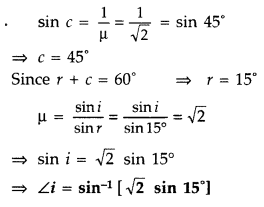Important Questions for Class 12 Physics Chapter 9 Ray Optics and Optical Instruments Class 12 Important Questions
Ray Optics and Optical Instruments Class 12 Important Questions Very Short Answer Type
Question 1.
Aglasslensof refractive index 1.5 is placed in a trough of liquid. What must be the refractive index of the liquid in order to mark the lens disappear? (Delhi 2008)
Answer:
In order to make the lens disappear the refractive index of liquid must be equal to 1.5 i.e. equal to that of glass lens.
Question 2.
A converging lens of refractive index 1.5 is kept in a liquid medium having same refractive index. What would be the focal length of the lens in this medium? (Delhi 2008)
Answer:
The lens in the liquid will act like a plane sheet of glass
∴ Its focal length will be infinite (∞)
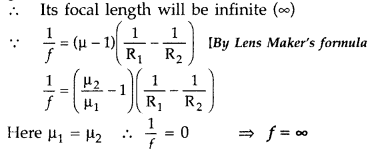
Question 3.
How does the power of a convex lens vary, if the incident red light is replaced by violet light? (Delhi 2008)
Answer:
According to Lens Maker’s formula

∴ power of the lens will be increased.
Question 4.
How does the angle of minimum deviation of a glass prism vary, if the incident violet light is replaced with red light? (All India 2008)
Answer:
We know that λ red > λ violet, therefore µ red < µ violet and hence δ red < δ violet.
When incident violet light is replaced with red light, the angle of minimum deviation of a glass decreases.
Question 5.
Why does the bluish colour predominate in a clear sky? (All India 2008)
Answer:
Blue colour of the sky : The scattering of light by the atmosphere is a colour dependent. According to Rayleigh’s law, the intensity of scattered light \(\mathrm{I} \propto \frac{1}{\lambda^{4}}\), blue light is scattered much more strongly than red light. Therefore, the colour of sky becomes blue. The blue component of light is proportionately more in the light coming from different parts of the sky. This gives the impression of the blue sky.
Question 6.
How does the angle of minimum deviation of a glass prism of refractive index 1.5 change, if it is immersed in a liquid of refractive index 1.3? (All India 2008)
Answer:
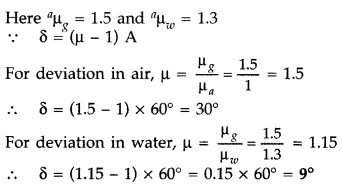
Hence angle of deviation is decreased.
Question 7.
You are given following three lenses. Which two lenses will you use as an eyepiece and as an objective to construct an astronomical telescope? (Delhi 2009)
| Lenses | Power (P) | Aperture |
| L 1 | 3D | 8 cm |
| L 2 | 6D | 1 cm |
| L 3 | 10D | 1 cm |
Answer:
Objective – Less power and more aperture. So L
1
Eyepiece – More power and less aperture. So L
3
.
Question 8.
Two thin lenses of power + 4D and – 2D are in contact. What is the focal length of the combination? (All India 2009)
Answer:
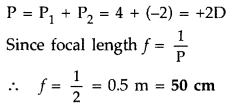
Question 9.
Two thin lenses of power + 6D and – 2D are in contact. What is the focal length of the combination? (All India 2009)
Answer:

Question 10.
A glass lens of refractive index 1.45 disappears when immersed in a liquid. What is the value of refractive index of the liquid? (Delhi 2010)
Answer:
The value of refractive index of the liquid should be 1.45 so that the glass lens of refractive index 1.45 disappears when immersed in a liquid.
Question 11.
State the conditions for the phenomenon of total internal reflection to occur. (Delhi 2010)
Answer:
Two essential conditions for total internal reflection are :
- Light should travel from an optically denser medium to an optically rarer medium.
- The angle of incidence in the denser medium must be greater than the critical angle for the two media.
Question 12.
Calculate the speed of light in a medium whose critical angle is 30°. (Delhi 2010)
Answer:

∴ Speed of light, v = 1.5 × 10
8
ms
-1
Question 13.
A converging lens is kept coaxially in contact with a diverging lens — both the lenses being of equal focal lengths. What is the focal length of the combination? (Delhi 2010)
Answer:
Focal length of the combination is Infinity.
Question 14.
When light travels from a rarer to a denser medium, the speed decreases. Does this decrease in speed imply a decrease in the energy carried by the light wave? Justify your answer. (All India 2010)
Answer:
No, the energy carried by the lightwave remains the same.
Reason : As energy E = hv

Here frequency remains same.
Question 15.
When monochromatic light travels from one medium to another its wavelength changes but frequency remains the same. Explain. (Delhi 2011)
Answer:
If v
1
and v
2
denote the velocity of light in medium 1 and medium 2 respectively and λ
1
and λ
2
denote the wavelength of light in medium 1 and medium 2. Thus
![]()
The above equation implies that when a wave gets refracted into denser medium (v
1
> v
2
) the wavelength and the speed of propagation decreases but the frequency v (\(=v / \lambda\)) remains the same.
Question 16.
Under what condition does a biconvex lens of glass having a certain refractive index act as a plane glass sheet when immersed in a liquid? (Delhi 2012)
Answer:
When the refractive index of glass of biconvex lens is equal to the refractive index of the liquid in which lens is immersed
or µ
1
= µ
g
Question 17.
For the same value of angle of incidence, the angles of refraction in three media A, B and C are 15°, 25° and 35° respectively. In which medium would the velocity of light be minimum? (All India 2012)
Answer:
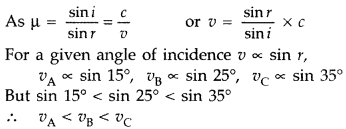
∴ Velocity of light is minimum in medium A.
Question 18.
How would a biconvex lens appear when placed in a trough of liquid having the same refractive index as that of the lens? (Comptt. Delhi 2011)
Answer:
A biconvex lens appears plane glass when placed in a trough of liquid having the same refractive index as that of the lens.
Question 19.
Two thin lenses of power -4D and 2D are placed in contact coaxially. Find the focal length of the combination. (Comptt. All India 2011)
Answer:
Power of combination = – 4D + 2D = – 2D
![]()
∴ Focal length, f = – 50 cm
Question 20.
Two thin lenses of power -2D and 2D are placed in contact coaxially. What is the focal length of the combination? (Comptt. All India 2011)
Answer:
Power of combination = -2D + 2D = 0
![]()
Question 21.
Write the relationship between angle of incidence ‘i’, angle of prism ‘A’ and angle of minimum deviation for a triangular prism. (Delhi 2013)
Answer:
![]()
where [δ
m
is angle of minimum deviation]
Question 22.
When red light passing through a convex lens is replaced by light of blue colour, how will the focal length of the lens change? (Comptt. All India 2013)
Answer:
Focal length of lens will decrease \(\mu_{v}>\mu_{r}\)
Question 23.
If the wavelength of light incident on a convex lens is increased, how will its focal length change? (Comptt. All India 2013)
Answer:

Question 24.
A convex lens is placed in contact with a plane mirror. A point object at a distance of 20 cm on the axis of this combination has its image coinciding with itself. What is the focal length of the lens? ‘ (Delhi 2014)
Answer:
Focal length of lens = 20 cm
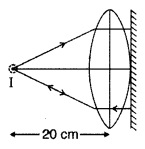
(Hint: Rays coming out of lens are incident normally on plain mirror and hence reflected rays will trace the path of incident ray, hence forming image on the object itself, thus object and image overlapping each other at F of convex lens.)
Question 25.
A biconvex lens made of a transparent material of refractive index 1.25 is immersed in water of refractive index 1.33. Will the lens behave as a converging or a diverging lens? Give reason. (All India 2014)
Answer:
The lens will behave as a diverging lens, because -1)
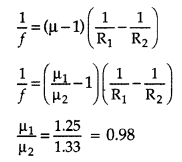
The value of (µ – 1) is negative and ‘f’ will be negative.
Question 26.
A biconvex lens made of a transparent material of refractive index 1.5 is immersed in water of refractive index 1.33. Will the lens behave as a converging or a diverging lens? Give reason. (All India 2014)
Answer:
The lens will behave as a converging lens because
![]()
Hence value of ‘f’ will be positive.
Question 27.
A concave lens of refractive index 1.5 is immersed in a medium of refractive index 1.65. What is the nature of the lens? (Delhi 2015)
Answer:
Converging.
Question 28.
Why does bluish colour predominate in a clear sky? (All India 2015)
Answer:
Blue colour of the sky : The scattering of light by the atmosphere is a colour dependent. According to Rayleigh’s law, the intensity of scattered light \(\mathrm{I} \propto \frac{1}{\lambda^{4}}\), blue light is scattered much more strongly than red light. Therefore, the colour of sky becomes blue. The blue component of light is proportionately more in the light coming from different parts of the sky. This gives the impression of the blue sky.
Question 29.
When an object is placed between f and 2f of a concave mirror, would the image formed be
(i) real or virtual and
(ii) diminished or magnified? (Comptt. Delhi 2015)
Answer:
(i) Real
(ii) magnified
Question 30.
How does the angle of minimum deviation of a glass prism vary, if the incident violet light is replaced by red light? Give reason. (Delhi 2017)
Answer:
The angle of minimum deviation decreases, when violet light is replaced by red light because refractive index for violet light is more than that for red light.
Question 31.
An object is kept in front of a concave lens. What is the nature of the image formed? (Comptt. Delhi 2017)
Answer:
When an object is kept in front of a concave lens, the nature of image formed is virtual, erect and diminished.
Question 32.
When light travels from a rarer medium to denser medium, the speed of light decreases. Does the reduction in speed imply a reduction in the energy? (Comptt. Delhi 2017)
Answer:
The reduction in speed, due to light travelling from a rarer to denser medium does not imply reduction in the energy.
Question 33.
The objective lenses of two telescopes have the same apertures but their focal lengths are in the ratio 1: 2. Compare the resolving powers of the two telescopes. (Comptt. All India 2017)
Answer:
Ratio of resolving power = 1 : 1
Resolving power is same because it does not depend on focal length of the objective.
Question 34.
Why must both the objective and the eye piece of a compound microscope have short focal lengths? (Comptt. All India 2017)
Answer:
For getting higher magnification in compound microscope, both objective and eyepiece must have short focal length, because

Ray Optics and Optical Instruments Class 12 Important Questions Short Answer Type SA-I
Question 35.
Draw a ray diagram of a reflecting type telescope. State two advantages of this telescope over a refracting telescope. (Delhi 2008)
Answer:
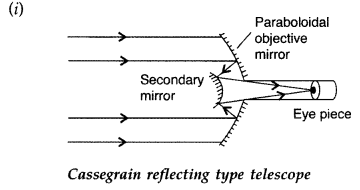
(ii) Advantages of reflecting telescope over a refracting telescope:
- Due to large aperture of the mirror used, the reflecting telescopes have high resolving power.
- This type of telescope is free from chromatic aberration (formation of coloured image of a white object).
- The use of paraboloidal mirror reduces the spherical aberration (formation of non-point, blurred image of a point object).
- Image formed by reflecting telescope is brighter than refracting telescope.
- A lens of large aperture tends to be very heavy and therefore difficult to make and support by its edges. On the other hand, a mirror of equivalent optical quality weights less and can be supported over its entire back surface.
Question 36.
Draw a ray diagram of an astronomical telescope in the normal adjustment position. State two drawbacks of this type of telescope. (Delhi 2008)
Answer:
(i) Magnifying power m = \(-\frac{f_{0}}{f_{e}}\). It does not change with increase of aperature of objective lens, because focal length of a lens has no concern with the aperature of lens.
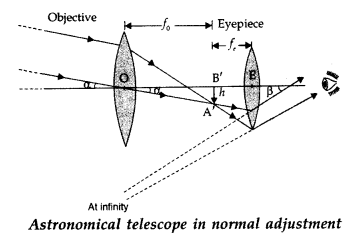
(ii) Drawbacks :
- Images formed by these telescopes have chromatic aberrations.
- Lesser resolving power.
- The image formed is inverted and faintes.
Question 37.
Draw a ray diagram of a compound microscope. Write the expression for its magnifying power.
(Delhi 2008)
Answer:
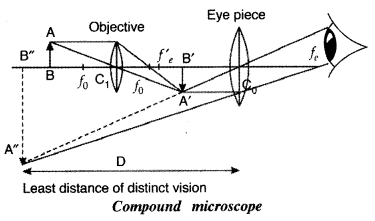
When the final image is formed at the least distance of distinct vision

Question 38.
Draw a labelled ray diagram of an astronomical telescope in the near point position. Write the expression for its magnifying power. (All India 2008)
Answer:
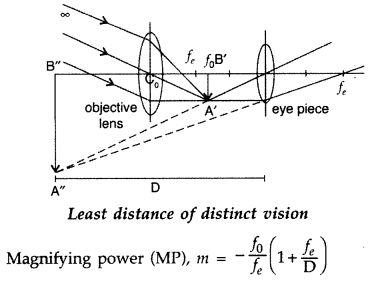
Question 39.
Draw a labelled ray diagram, showing the image formation of an astronomical telescope in the normal adjustment position. Write the expression for its magnifying power.(All India 2008)
Answer:
(i) Magnifying power m = \(-\frac{f_{0}}{f_{e}}\). It does not change with increase of aperature of objective lens, because focal length of a lens has no concern with the aperature of lens.

(ii) Drawbacks :
- Images formed by these telescopes have chromatic aberrations.
- Lesser resolving power.
- The image formed is inverted and faintes.
Question 40.
Draw a ray diagram for the formation of image in a compound microscope. Write the expression for its magnifying power. (All India 2008)
Answer:

When the final image is formed at the least distance of distinct vision
Question 41.
A ray of light passing through an equilateral triangular glass prism from air undergoes minimum deviation when angle of incidence is 3/4
th
of the angle of prism. Calculate the speed of light in the prism. (Delhi 2008)
Answer:
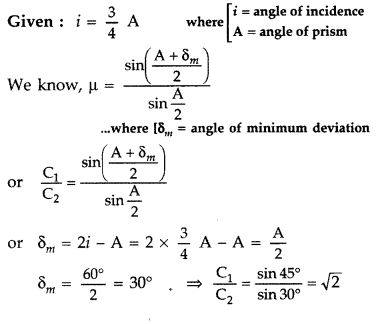
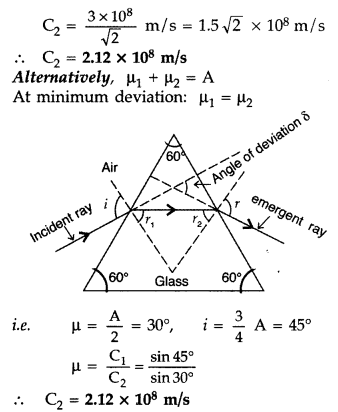
Question 42.
Calculate the distance of an object of height h from a concave mirror of focal length 10 cm, so as to obtain a real image of magnification 2. (Delhi 2008)
Answer:
Given : f = -10 cm; Magnification, m = 2
To calculate : u = ?
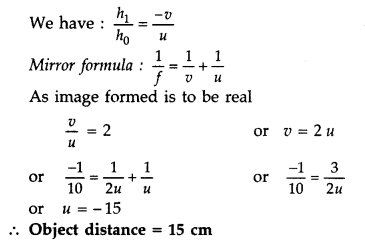
Question 43.
Define refractive index of a transparent medium. A ray of light passes through a triangular prism. Plot a graph showing the variation of the angle of deviation with the angle of incidence. (All India 2009)
Answer:
Refractive index of a transparent medium is the ratio of the speed of light in free space to the speed in the given medium.
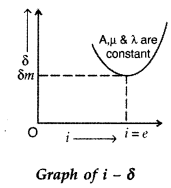
Question 44.
(i) What is the relation between critical angle and refractive index of a material?
(ii) Does critical angle depend on the colour of light? Explain. (All India 2009)
Answer:
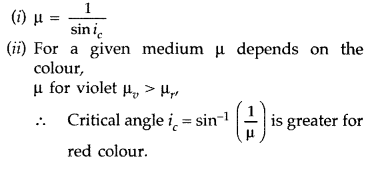
Question 45.
The radii of curvature of the faces of a double convex lens are 10 cm and 15 cm. If focal length of the lens is 12 cm, find the refractive index of the material of the lens. (Delhi 2010)
Answer:
Given : R
1
= 10 cm,
R
2
= -15 cm,
f = 12 cm
Using lens maker’s formula, we have
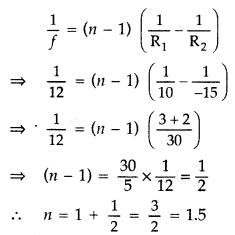
Refractive index of the material of the lens :
Question 46.
(a) The bluish colour predominates in clear sky.
(b) Violet colour is seen at the bottom of the spectrum when white light is dispersed by a prism.
State reasons to explain these observations. (Delhi 2010)
Answer:
(a) The scattering of light by the atmosphere is colour dependent. According to Rayleigh’s law, the intensity of scattered light, \(I \propto \frac{1}{\lambda_{4}}\)
Blue light is scattered much more strongly than red light. The blue component of light is proportionately more in the light coming from different parts of the sky. This gives the impression of the blue sky.
(b) As refractive index of prism is different for different colours, therefore, different colours deviate through different angles on passing through the prism. As λ violet < λ red therefore µ violet > µ red . Hence δ violet > δ red maximum deviation is of violet colour. That is why violet colour, is seen at the bottom of the spectrum when white light is dispersed by a prism.
Question 47.
A biconvex lens has a focal length 2/3 times the radius of curvature of either surface. Calculate the refractive index of lens material.
Answer:
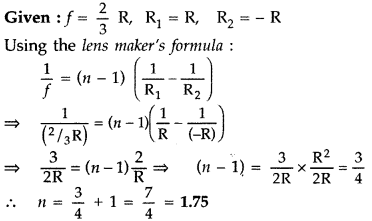
Question 48.
(i) Why does the Sun appear reddish at sun-set or sun-rise?
(ii) For which colour the refractive index of prism material is maximum and minimum? (Delhi 2009).
Answer:
(i) During Sunrise or sunset, the Sun is near the horizon. Sunlight has to travel a greater distance. So shorter waves of blue region are scattered away by the atmosphere. Red waves of longer wavelength are least scattered and reach the observer. So the Sun appears reddish.
(ii) Refractive index of prism material is maximum for violet colour and refractive index of prism material is minimum for red colour.
Question 49.
Find the radius of curvature of the convex surface of a plano-convex lens, whose focal length is 0.3 m and the refractive index of the material of the lens is 1.5. (Delhi 2009)
Answer:
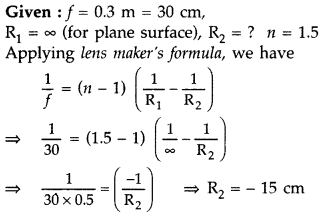
∴ Radius of curvature = -15 cm.
Question 50.
(i) Out of blue and red light which is deviated more by a prism? Give reason.
(ii) Give the formula that can be used to determine refractive index of material of a prism in minimum deviation condition. (Delhi 2009)
Answer:

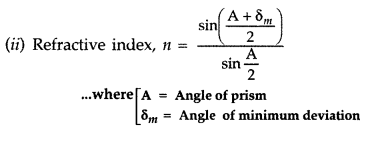
Question 51.
Two convex lenses of same focal length but of aperture Ar and A2 (A2 < A-,), are used as the objective lenses in two astronomical telescopes having identical eyepieces. What is the ratio of their resolving power? Which telescope will you prefer and why? Give reason. (Delhi 2009)
Answer:
Resolving power of a telescope is given by R.P.
![]()
From the given condition, the ratio of resolving power of two astronomical telescopes will be R.P, A,
![]()
Telescope with large aperture (A
1
) should be preferred as it increases the resolution by collecting more light.
Question 52.
A ray of light, incident on an equilateral glass prism (µ
g
= \(\sqrt{3}\) ) moves parallel to the base line of the prism inside it. Find the angle of incidence for this ray.
Answer:
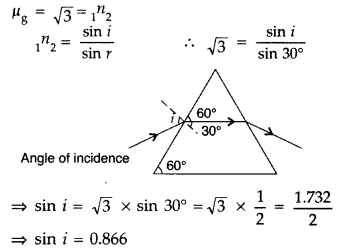
∴ Angle of incidence, i = 60°
Question 53.
An object AB is kept in front of a concave mirror as shown in the figure.
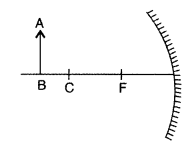
(i) Complete the ray diagram showing the image formation of the object.
(ii) How will the position and intensity of the image be affected if the lower half of the mirror’s reflecting surface is painted black? (All India 2012)
Answer:
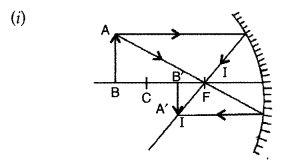
(ii) When the lower half of the mirror is painted black, the image formed is still of the same size as that with unpainted mirror but the intensity of the image has now reduced.
Question 54.
Draw a labelled ray diagram of a reflecting telescope. Mention its two advantages over the refracting telescope. (All India 2012)
Answer:
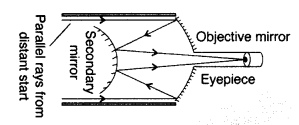
Two advantages over the refracting telescope :
- There is no chromatic aberration as the objective is a mirror.
- Spherical aberration is reduced using mirror objective in the form of a paraboloid.
- Image is brighter compared to that in a refracting type telescope.
- Higher resolving power. (any two)
Question 55.
(a) Plane and convex mirrors are known to produce virtual images of the objects. Draw a ray diagram to show how, in the case of convex mirrors, virtual objects can produce real images.
(b) Why are convex mirrors used as side view mirrors in vehicles? (Comptt. Delhi 2012)
Answer:
(a) When rays incident on a plane. mirror or convex mirror are tendmg to converge to a point behind the mirror, they are reflected ‘ to a point on a screen in front of the mirror. Hence, a real image is formed (when the object is virtual).
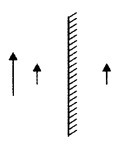
(b) A convex mirror is used as side view mirror in vehicles because it has larger field of view as compared to other mirror. The image formed is small and erect.
Question 56.
(a) Draw a ray diagram for a convex minor showing the image formation of an object placed anywhere in front of the minor.
(b) Use this ray diagram to obtain the expression for its linear magnification. (Comptt. All India 2012)
Answer:
(a) Ray diagram
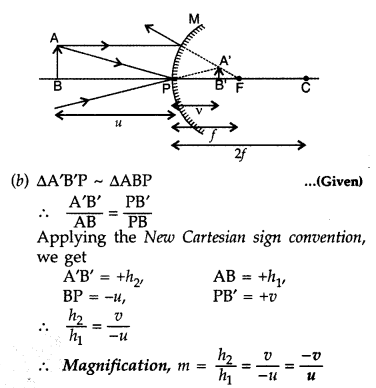
Question 57.
(a) Draw a ray diagram for a concave minor showing the image formation of an object placed anywhere in front of a minor.
(b) Using the ray diagram, obtain the expression for its linear magnification. (Comptt. All India 2012)
Answer:
(a) Ray diagram :
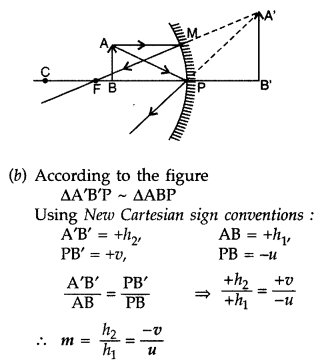
Question 58.
Deduce, with the help of ray diagram, the expression for the mirror equation in the case of convex minor. ‘ (Comptt All India 2012)
Answer:
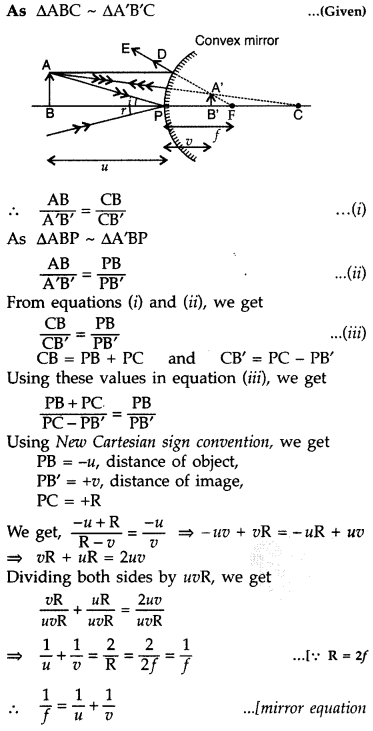
Question 59.
A convex lens of focal length 25 cm is placed coaxially in contact with a concave lens of focal length 20 cm. Determine the power of the combination. Will the system be converging or diverging in nature? (Delhi 2013)
Answer:
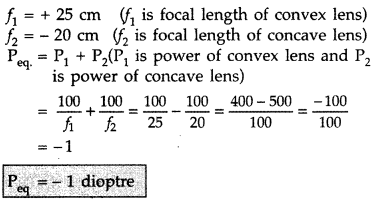
The system will be a diverging lens as it has negative power.
Question 60.
Draw a ray diagram showing the image formation by a compound microscope. Hence obtain the expression for total magnification when the image is formed at infinity. (Delhi 2013)
Answer:
Ray Diagram:
(a) Ray diagram of a compound microscope : A schematic diagram of a compound microscope is shown in the figure. The lens nearest the object, called the objective, forms a real, inverted, magnified image of the object. This serves as the object for the second lens, the eyepiece, which functions essentially like a simple microscope or magnifier, produces the final image, which is enlarged and virtual. The first inverted image is thus near (at or within) the focal plane of the eyepiece, at a distance appropriate for final image formation at infinity, or a little closer for image formation at the near point. Clearly, the final image is inverted with respect to the original object.
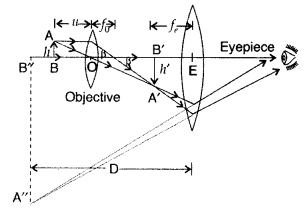
Magnification due to a compound microscope.
The ray diagram shows that the (linear) magnification due to the objective, namely h’/h, equals

Here h’ is the size of the first image, the object size being h and f
0
being the focal length of the objective. The first image is formed near the focal point of the eyepiece. The distance L, i.e., the distance between the second focal point of the objective and the first focal point of the eyepiece (focal length f
e
) is called the tube length of the compound microscope.
As the first inverted image is near the focal point of the eyepiece, we use for the simple microscope to obtain the (angular) magnification me due to it when the final image is formed at the near point, is
![]()
When the final image is formed at infinity, the angular magnification due to the eyepiece, me = (D//e)
![]()
Thus, the total magnification from equation (i) and (iii), when the image is formed at infinity, is
![]()
(b) Resolving power of a microscope :
![]()
(i) The focal length of the objective lens has no effect on the resolving power of microscope.
(ii) When the wavelength of light is increased, the resolving power of a microscope
![]()
Expression for total magnification when image is formed at infinity:
Magnification of object,
![]()
Angular magnification due to eye piece,
![]()
Total magnification when image is formed at infinity
![]()
Question 61.
A convex lens of focal length 30 cm is placed coaxially in contact with a concave lens of focal length 40 cm. Determine the power of the combination. Will the system be converging or diverging in nature? (Delhi 2013)
Answer:
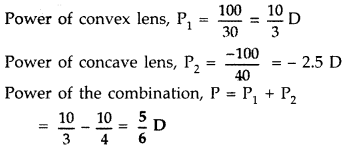
The system is converging in nature.
Question 62.
A convex lens of focal length f
1
is kept in contact with a concave lens of focal length fr Find the focal length of the combination. (All India 2013)
Answer:
f
1
➝ is focal length of convex lens
f
1
➝ is focal length of concave lens.
f
net
➝ be the focal length of the combination. The power of the combination is the sum of the two powers.
So, net focal length of combined lens is

Question 63.
Draw a schematic arrangement of a reflecting telescope (Cassegrain) showing how rays coming from a distant object are received at the eye-piece. Write its two important advantages over a refracting telescope. (Comptt. Delhi 2013)
Answer:
Reflecting telescope. Telescope with mirror objectives is called reflecting telescope. This is also known as Cassegrain telescope / Newtonian telescope. The ray diagram of reflecting type telescope is shown in figure.
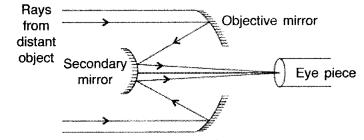
Advantage over refracting telescope :
- Since reflecting telescope has mirror objective, so the image formed is free from chromatic aberration.
- Since the spherical mirrors are parabolic mirrors, free from spherical aberration, they produce a very sharp and distinct image.
Question 64.
Draw a labelled ray diagram of refracting type telescope in normal adjustment. Write two main considerations required of an astronomical telescope. (Comptt. Delhi 2013)
Answer:
Refracting telescope :
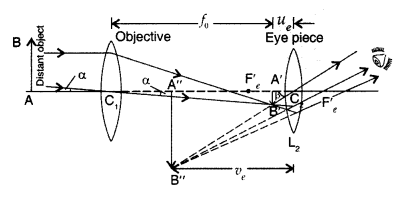
Magnifying power. It is defined as the ratio of angle (β) subtended by the final image on the eye to the angle (α) subtended by object on eye.
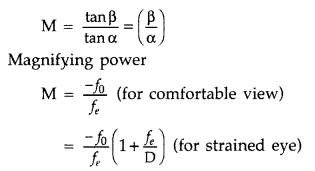
Limitations of refracting telescope over a a reflecting type telescope :
- It suffers from chromatic aberration due to refraction and hence the image obtained is multicoloured and blurred.
- As a lens of large apparatus can’t be manufactured easily, its light gathering power is low and hence can’t be used to see faint stars.
Question 65.
Draw a labelled ray diagram of a compound microscope. Why are the objective and the eye-piece chosen to have small focal length? (Comptt. Delhi 2013)
Answer:
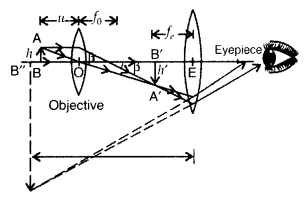
- If the focal lengths are less, then their magnifying power will be more.
- To avoid any aberration in refraction due to larger bend on passing through the eyepiece.
Question 66.
A ray of light passes through an equilateral prism in such a way that the angle of incidence is equal to the angle of emergence and each of these angles is 3/4 times the angle of the prism. Determine
(i) the angle of deviation and
(ii) the refractive index of the prism. (Comptt. All India 2013)
Answer:

We know, that δ + A = i + e
=> δ = z + e – A
∴ 8 = 45° + 45° – 60° = 30°
(i) angle of deviation = 30°
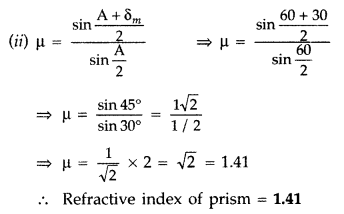
Question 67.
Two monochromatic rays of light are incident normally on the face AB of an isosceles right angled prism ABC. The refractive indices of the glass prism for the two rays ‘1’ and ‘2’ are respectively 1.35 and 1.45. Trace the path of these rays entering through the prism. (All India 2014)
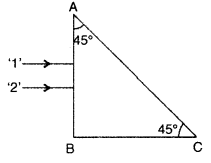
Answer:
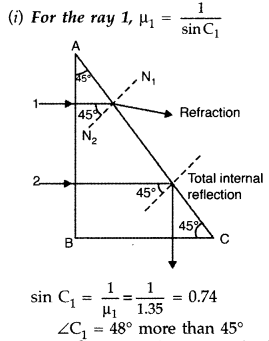
Since the angle of incidence (45°) is less than the critical angle (48°), the ray will be refracted.
(ii) For the ray 2,

Since the angle of incidence (45°) is more than the critical angle (43°), the ray will be total internally reflected.
Question 68.
Two monochromatic rays of light are incident normally on the face AB of an isosceles right-angled prism ABC. The refractive indices of the glass prism for the two rays ‘T and ‘2’ are respectively 1.3 and 1.5. Trace the path of these rays after entering through the prism. (All India 2014)
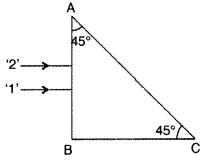
Answer:

Since the angle of incidence (45°) is more than the critical angle (42°), the ray will be total internally reflected.
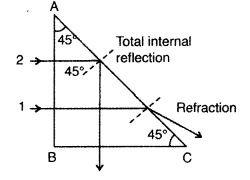
(ii) For the ray 1,

Since the angle of incidence (45°) is less than the critical angle (50°) the ray will be total refracted.
Question 69.
Draw a schematic diagram of a reflecting telescope (Cassegrain). Write its two advantages over a refracting telescope. (Comptt. Delhi 2014)
Answer:
Reflecting telescope. Telescope with mirror objectives is called reflecting telescope. This is also known as Cassegrain telescope / Newtonian telescope. The ray diagram of reflecting type telescope is shown in figure.

Advantage over refracting telescope :
- Since reflecting telescope has mirror objective, so the image formed is free from chromatic aberration.
- Since the spherical mirrors are parabolic mirrors, free from spherical aberration, they produce a very sharp and distinct image.
Question 70.
Draw a ray diagram for the formation of image by a compound microscope. Write the expression for total magnification when the image is formed at infinity. (Comptt. Delhi 2014)
Answer:
Compound Microscope :
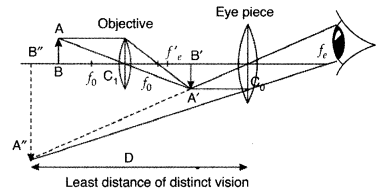
Magnifying power : The magnifying power of a compound microscope is defined as the ratio of the angle subtended at the eye by the final virtual image to the angle subtended at the eye by the object, when both are at the least distance of distinct vision from the eye.
Numerical:
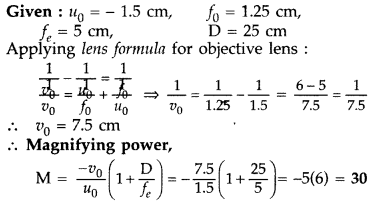
The -ve sign shows that the final image is an inverted image.
The expression magnifying power of compound microscope when the final image is formed at infinity is :

Question 71.
Write the conditions for observing a rainbow. Show, by drawing suitable diagrams, how one understands the formation of a rainbow. (Comptt. All India 2014)
Answer:
The conditions for observing a rainbow are:
- The Sun comes out after a rainfall.
- The observer stands with the Sun towards his/her back.
Formation of a rainbow
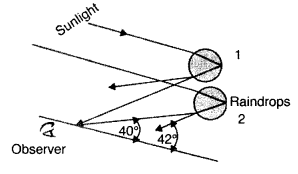
- The rays of light reach the observer through a refraction, followed by a reflection followed by a refraction.
- Figure shows red light from drop 1 and violet light from drop 2, reaching the observer’s eye.
Question 72.
Use the mirror equation to show that an object placed between f and 2f of a concave mirror produces a real image beyond 2f. (Delhi 2014)
Answer:
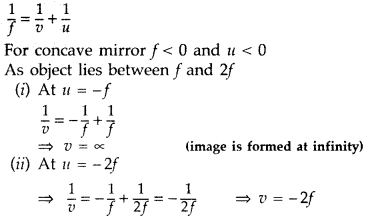
Hence, image distance v ≥ -2f
Since, v is negative therefore the image is real.
Question 73.
You are given two converging lenses of focal lengths 1.25 cm and 5 cm to design a compound microscope. If it is desired to have a magnification of 30, find out the separation between the objective and the eyepiece. (All India 2014)
Answer:
(a) When the image lies at infinity
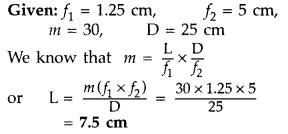
(b) When the image is formed at the near point

30 × 1.25 = L × 6
L = 5 × 1.25 = 6.25 cm
Question 74.
A small telescope has an objective lens of focal length 150 cm and eyepiece of focal length 5 cm. What is the magnifying power of the telescope for viewing distant objects in normal adjustment?
If this telescope is used to view a 100 m tall tower 3 km away, what is the height of the image of the tower formed by the objective lens? (All India 2014)
Answer:
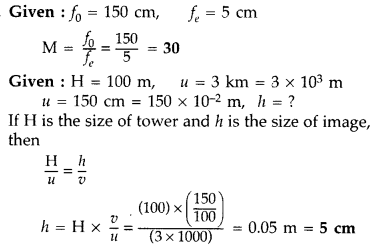
Question 75.
Why does white light disperse when passed through a glass prism?
Using lens maker’s formula, show how the focal length of a given lens depends upon the colour of light incident on it. (Comptt. Delhi 2014)
Answer:
(i) The white light disperses when passed through a prism, because the refractive index of the glass of the prism is different for different wavelengths (colours). Hence, different colours get bent along different directions.
(ii) Using lens maker’s formula,

As the refractive index of the medium (n
2
) (glass) with respect to air (n
1
) depends on the wavelength or colour of light, therefore focal length of the lens would change with colour.
Question 76.
A ray PQ incident normally on the refracting face BA is refracted in the prism BAC made of material of refractive index 1.5. Complete the path of ray through the prism. From which face will the ray
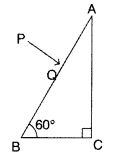
Answer:
(i) The ray will emerge from the face AC as shown. A
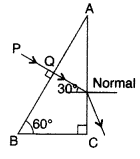
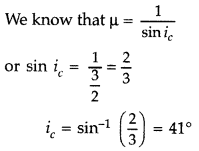
The angle of incidence (i) on the face AC is 30°, which is < i
c
, hence the ray will emerge as shown in the diagram, and will NOT be reflected back.
Question 77.
Draw a ray diagram to show how a right angled isosceles prism may be used to “bend the path of light rays by 90°”.
Write the necessary condition in terms of the refractive index of the material of this prism for the ray to bend to 90°. (Comptt. Delhi 2014)
Answer:
(a) Ray diagram
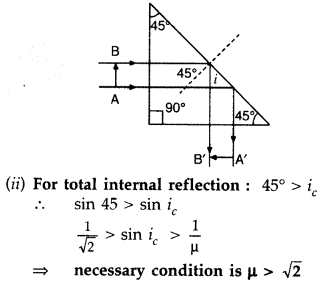
Question 78.
The image of an object, formed by a combination of a convex lens (of focal length f) and a convex mirror (of radius of curvature R), set up, as shown is observed to coincide with the object.
Redraw this diagram to mark on it the position of the centre of curvature of the mirror.
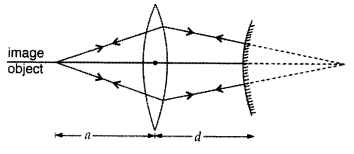
Obtain the expression for R in terms of the distances, marked as a and d, and the focal length, l, of the convex lens. (Comptt. Delhi 2014)
Answer:
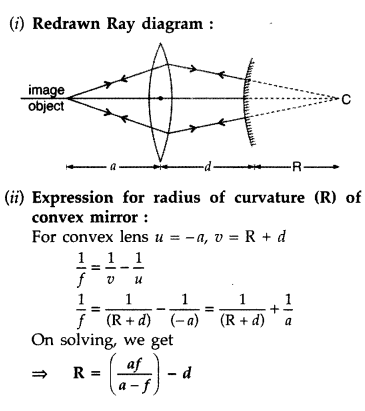
Question 79.
Define the magnifying power of a compound microscope when the final image is formed at infinity. Why must both the objective and the eyepiece of a compound microscope have short focal lengths? Explain. (Delhi 2016)
Answer:
Definition : Magnifying power of a compound microscope is defined as “the angle subtended at the eye by the image to the angle subtended (at the unaided eye) by the object”.
Reason : To increase the magnifying power, both the objective and the eyepiece must have short

Question 80.
Why should the objective of a telescope have large focal length and large aperture? Justify your answer.
Answer:
Large focal length : to increasing magnifying power.

Question 81.
A small illuminated bulb is at the bottom of a tank, containing a liquid of refractive index upto a height H. Find the expression for the diameter of an opaque disc, floating symmetrically on the liquid surface in order to cut-off the light from the bulb. (Comptt. Delhi 2016)
Answer:
It is only the light coming out from a cone of
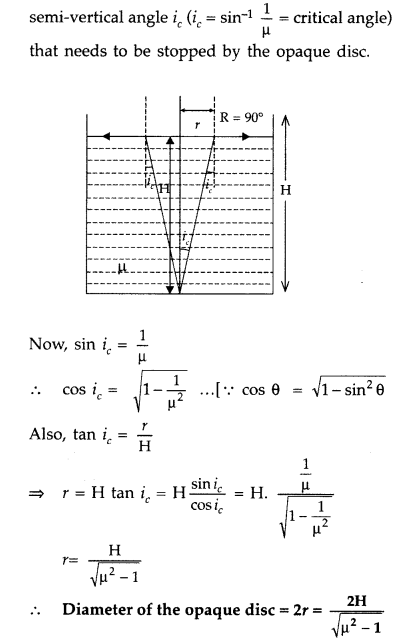
Question 82.
A ray of light is incident on a glass prism of refractive index and refractive angle A. If it just suffers total internal reflection at the other face, obtain an expression relating the angle of incidence, angle of prism and critical angle. (Comptt. Delhi 2017)
Answer:
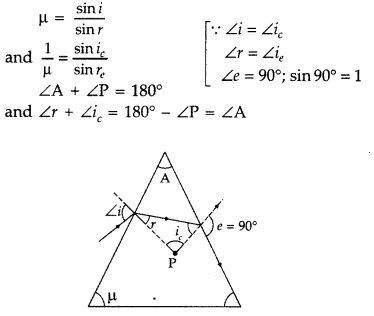

Question 83.
(i) Define refractive index of a medium.
(ii) In the following ray diagram, calculate the speed of light in the liquid of unknown refractive index. (Comptt. All India 2017)
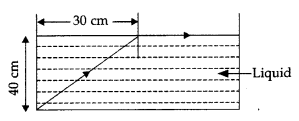
Answer:
(i) The refractive index of a medium is defined as the ratio of speed of light in vacuum (c) to the speed of light in the medium (v)
![]()
(ii) Given : Width of liquid surface (w) = 30 cm
Depth of liquid (d) = 40 cm
Since it is a critical case of total internal reflection, when refracted ray gazes along the liquid surface.

From the given ray diagram, the length of ray inside liquid is 50 cm
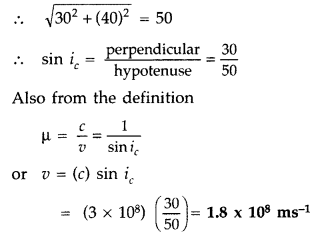
Ray Optics and Optical Instruments Class 12 Important Questions Short Answer Type SA-II
Question 84.
With the help of a suitable ray diagram, derive the mirror formula for a concave mirror. (All India 2009)
Answer:
Consider a concave mirror of focal length/, radius of curvature R receiving light from an object AB placed between F and C as shown in the figure. The image will be formed as shown in the ray diagram.
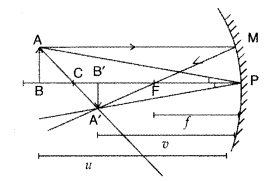
Using Cartesian sign convention, we find
Object distance, BP = – u
Image distance B’P = – v
Focal length, FP = – l
Radius of curvature, CP = -R = -2f
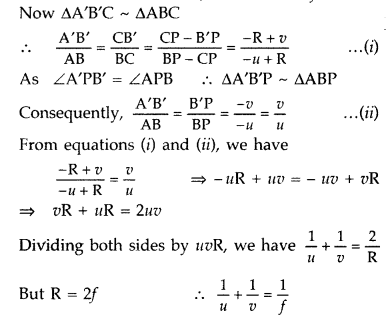
This proves the mirror formula for a concave mirror.
Question 85.
Three light rays red (R), green (G) and blue (B) are incident on a right B angled prism ‘abc’ Q at face ‘ab’. The R refractive indices of the material of the prism for red, green and blue wavelengths are 1.39, 1.44 and 1.47 respectively. Out of the three which colour ray will emerge out of face ‘ac’? Justify your answer. Trace the path of these rays after passing through face ‘ab’. (Delhi 2009)
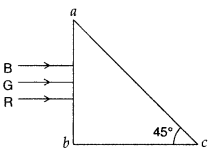
Answer:
Critical angle i
c
for total internal reflection is related to refractive index µ as

Critical angle for :


Incident angle in the surface ac is 45° for all the three colours. So red colour will undergo refraction while the other two colours will undergo total internal reflection in a.c. It is indicated in the figure. All the three colours will undergo total internal reflection if they are incident normally on one of the faces of an equilateral prism as shown in Figure 3. This is due to the reason that the incident angle on the second surface will be greater than critical angle for all the colours.
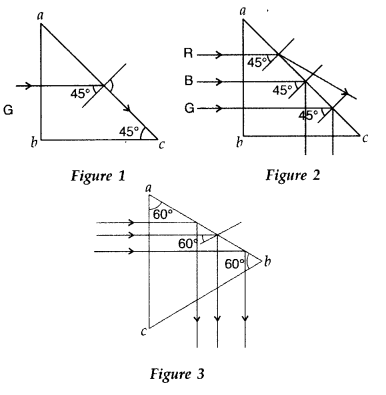
Question 86.
(i) Draw a neat labelled ray diagram of an astronomical telescope in normal adjustment. Explain briefly its working.
(ii) An astronomical telescope uses two lenses of powers 10 D and 1 D. What is its magnifying power in normal adjustment? (All India 2009)
Answer:
(i) Magnifying power m = \(-\frac{f_{0}}{f_{e}}\). It does not change with increase of aperature of objective lens, because focal length of a lens has no concern with the aperature of lens.

(ii) Drawbacks :
- Images formed by these telescopes have chromatic aberrations.
- Lesser resolving power.
- The image formed is inverted and faintes.
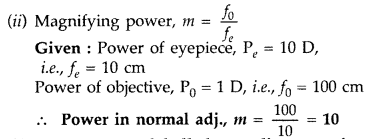
Question 87.
(i) Draw a neat labelled ray diagram of a compound microscope. Explain briefly its working.
(ii) Why must both the objective and the eye-piece of a compound microscope have short focal lengths? (All India 2010)
Answer:
(i)
(a) Ray diagram of a compound microscope : A schematic diagram of a compound microscope is shown in the figure. The lens nearest the object, called the objective, forms a real, inverted, magnified image of the object. This serves as the object for the second lens, the eyepiece, which functions essentially like a simple microscope or magnifier, produces the final image, which is enlarged and virtual. The first inverted image is thus near (at or within) the focal plane of the eyepiece, at a distance appropriate for final image formation at infinity, or a little closer for image formation at the near point. Clearly, the final image is inverted with respect to the original object.

Magnification due to a compound microscope.
The ray diagram shows that the (linear) magnification due to the objective, namely h’/h, equals

Here h’ is the size of the first image, the object size being h and f
0
being the focal length of the objective. The first image is formed near the focal point of the eyepiece. The distance L, i.e., the distance between the second focal point of the objective and the first focal point of the eyepiece (focal length f
e
) is called the tube length of the compound microscope.
As the first inverted image is near the focal point of the eyepiece, we use for the simple microscope to obtain the (angular) magnification me due to it when the final image is formed at the near point, is
![]()
When the final image is formed at infinity, the angular magnification due to the eyepiece, me = (D//e)
![]()
Thus, the total magnification from equation (i) and (iii), when the image is formed at infinity, is
![]()
(b) Resolving power of a microscope :
![]()
(i) The focal length of the objective lens has no effect on the resolving power of microscope.
(ii) When the wavelength of light is increased, the resolving power of a microscope
![]()
(ii) The magnifying power of a compound microscope is given by,

Angular magnification (m
0
) of objective will be large when u
0
is slightly greater than f
0
. Since microscope is used for viewing very close objects, so u0 is small. Consequently f
0
has to be small.
Moreover, the angular magnification (m
e
) of the eyepiece will be large if f
0
is small.
Question 88.
An illuminated object and a screen are placed 90 cm apart. Determine the focal length and nature of the lens required to produce a clear image on the screen, twice the size of the object. (All India 2010)
Answer:
According to the question,
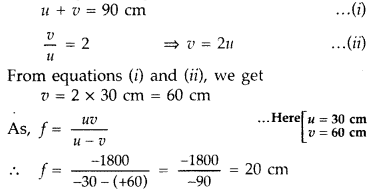
Nature of lens : Convex lens of focal length 20 cm is required.
Question 89.
The image obtained with a convex lens is erect and its length is four times the length of the object. If the focal length of the lens is 20 cm, calculate the object and image distances. (All India 2010)
Answer:
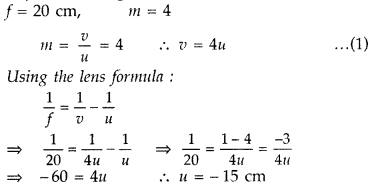
Putting the value of u in eqn (i), we get v = – 60 cm
∴ Object distance, u = 15 cm and
Image distance, v = 60 cm.
Question 90.
A convex lens is used to obtain a magnified image of an object on a screen 10 m from the lens. If the magnification is 19, find the focal length of the lens. (All India 2010)
Answer:
Given : u = -10 m, m = 19
For real image m = -19
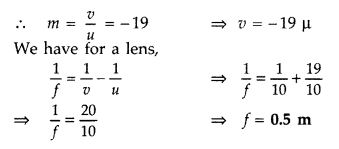
Question 91.
Draw a ray diagram to show refraction of a ray of monochromatic light passing through a glass prism.
Deduce the expression for the refractive index of glass in terms of angle of prism and angle of minimum deviation. (Delhi 2011)
Answer:
Ray diagram : The minimum deviation Dm, the refracted ray inside the prism becomes parallel to its base, we have
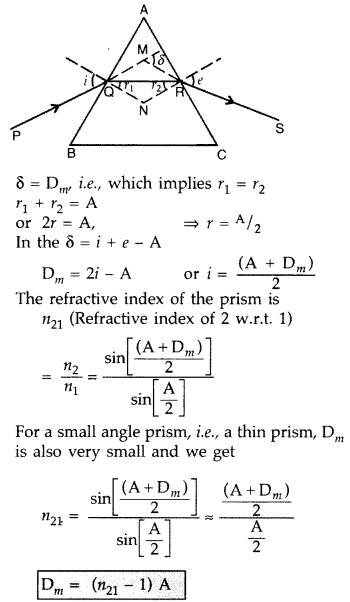
Question 92.
Use the mirror equation to show that
(a) an object placed between / and 2/ of a concave mirror produces a real image beyond 2f.
(b) a convex mirror always produces a virtual image independent of the location of the object.
(c) an object placed between the pole and focus of a concave mirror produces a virtual and enlarged image. (All India 2011)
Answer:
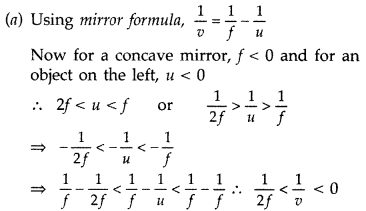
This implies that v < 0, formed on left. Also the above inequality implies 2f > v
![]()
i.e., the real image is formed beyond 2f.
(b) For a convex mirror, f > 0 and for an object on left, u < 0. From the mirror formula, \(\frac{1}{v}=\frac{1}{f}-\frac{1}{u}\) This implies that \(\frac{1}{v}\) > 0 or v > 0 v
This shows that whatever be the value of u, a convex mirror forms a virtual image on the right.
(c) From mirror formula : \(\frac{1}{v}=\frac{1}{f}-\frac{1}{u}\)
For a concave mirror, f < 0 and for an object located between the pole and focus of a concave mirror, f < u < 0
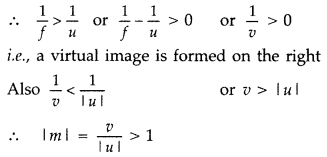
i.e., image is enlarged
Question 93.
A compound microscope uses an objective lens of focal length 4 cm and eyepiece lens of focal length 10 cm. An object is placed at 6 cm from the objective lens. Calculate the magnifying power of the compound microscope. Also calculate the length of the microscope. (All India 2011)
Answer:
Given f
0
= 4 cm, f
e
= 10 cm, u
0
= -6 cm
Magnifying power of microscope
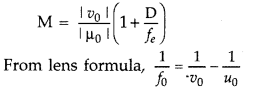
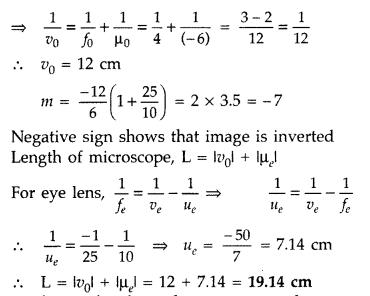
Question 94.
A giant refracting telescope at an observatory has an objective lens of focal length 15 m. If an eyepiece lens of focal length 1.0 cm is used, find the angular magnification of the telescope.
If this telescope is used to view the moon, what is the diameter of the image of the moon formed by the objective lens? The diameter of the moon is 3.42 × 10
6
m and the radius of the lunar orbit is 3.8 × 10
6
m. (All India 2011)
Answer:
Given : f
0
= 15 m, f
e
= 1.0 cm = 0.01 m
![]()
(ii) Let d be the diameter of the image in metres Then angle subtended by the moon will be

Angle subtended by the image formed by the objective will also be equal to a and is given by
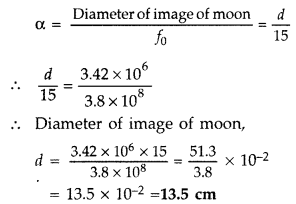
Question 95.
A convex lens made up of glass of refractive index 1.5 is dipped, in turn,
(i) a medium of refractive index 1.6,
(ii) a medium of refractive index 1.3.
(a) Will it behave as a converging or a diverging lens in the two cases?
(b) How will its focal length change in the two media? (All India 2011)
Answer:
![]()
Let f
air
be the focal length of the lens in air
According to lens maker formula :
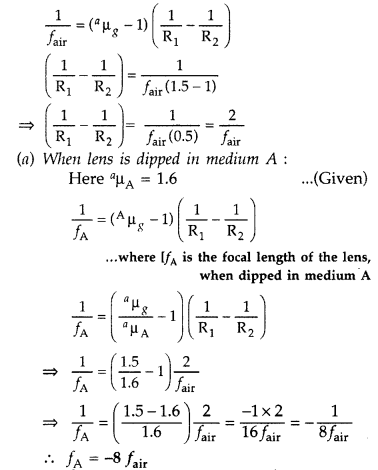
As the sign of f
B
is opposite to that of f
air
, the lens will behave as a diverging lens.
(b) When lens is dipped in medium B :
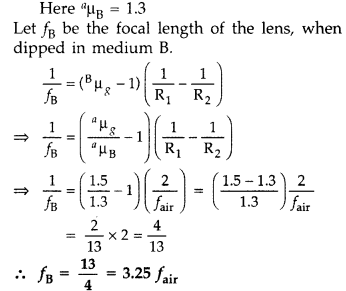
As the sign of f
B
is same as that of /air, the lens will behave as a converging lens.
Question 96.
A converging lens has a focal length of 20 cm in air. It is made of a material of refractive index 1.6. It is immersed in a liquid of refractive index 1.3. Calculate its new focal length. (All India 2011)
Answer:
According to lens maker formula :
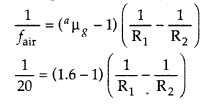
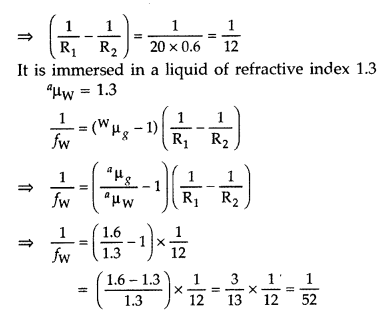
New focal length, f
w
= 52 cm
Question 97.
A convex lens made up of glass of refractive index 1.5 is dipped, in turn, in
(i) a medium of refractive index 1.65,
(ii) a medium of refractive index 1.33.
(a) Will it behave as a converging or a diverging lens in the two cases?
(b) How will its focal length change in the two media? (All India 2011)
Answer:
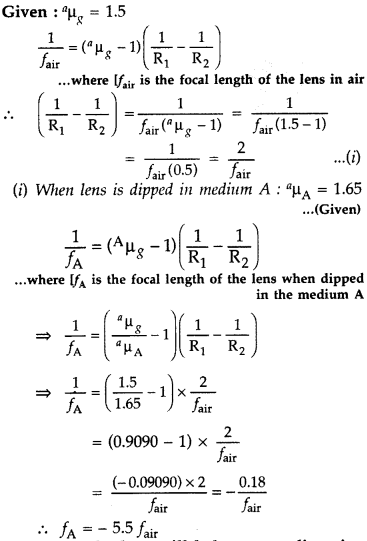
Hence the lens will behave as a diverging lens.
(ii) When lens is dipped in medium B : \(a_{\mu_{\mathrm{B}}}=1.33\)
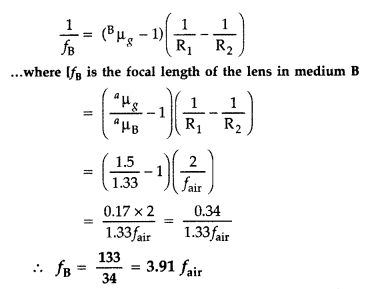
Hence the lens will behave as a converging lens.
Question 98.
You are given three lenses L
1
L
2
and L
3
each of focal length 20 cm. An object is kept at 40 cm in front of L
1
, as shown. The final real image is formed at the focus T of L
3
. Find the separations between L
1
, L
2
and L
3
.

Answer:
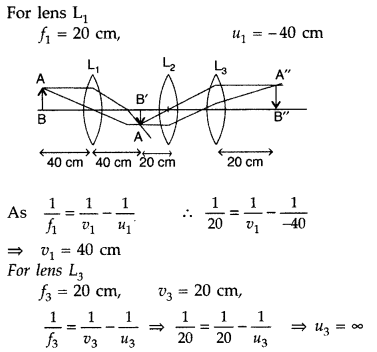
This shows that for lens L
2
the object should be at focus of that lens.
Hence the distance between L
1
and L
2
= v
1
+ f
2
= 40 + 20 = 60 cm
It clearly indicates that the distance between L
2
and L
3
can have any value.
Question 99.
You are given three lenses L
1
L
2
and L
3
each of focal length 15 cm. An object is kept at 20 cm in front of L
1
, as shown. The final real image is formed at the focus ‘I’ of L
3
. Find the separations between L
1
, L
2
and L
3
.

Answer:
Let f
1
f
2
and f
3
be the focal length of three lenses.
For lens L
1
: u = 20 cm

It shows that lens infinite.
Hence for lens L
1
, image is formed at a distance of 15 cm from L
2
∴ the focus of L
2
i.e. u
2
= 15 cm
Now, to calculate the distance between L
1
and L
2
,
u
1
+ H
2
= 60 + 15 = 75 cm
Distance between L
2
and L
3
= v
2
+ v
3
= ∞ or can be any value.
Question 100.
A fish in a water tank sees the outside world as if it (the fish) is at the vertex of a cone such that the circular base of the cone coincides with the surface of water. Given the depth of water, where fish is located, being ‘h’ and the critical angle for water-air interface being ‘i
c
‘, find out by drawing a suitable ray diagram the relationship between the radius of the cone and the height ‘h’. (Comptt. Delhi 2012)
Answer:
Let the fish beat point B, and OA is the base of the water
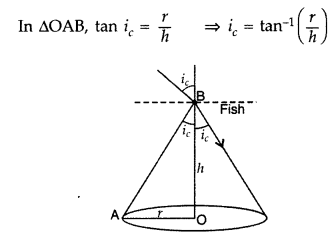
Question 101.
Draw a ray diagram to show the formation of the image of an object placed on the axis of a convex refracting surface, of radius of curvature ‘R’, separating the two media of refractive indices “n
1
and ‘n
2
‘ (n
2
> n
1
). Use this diagram to
deduce the relation \(\frac{n_{2}}{v}-\frac{n_{1}}{u}=\frac{n_{2}-n_{1}}{\mathbf{R}}\), where u and v represent respectively the distance of the object and the image formed. (Comptt. Delhi 2012)
Answer:
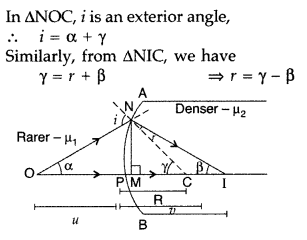
Suppose all the rays are paraxial
Then the angles i, r, a, P and y will be small
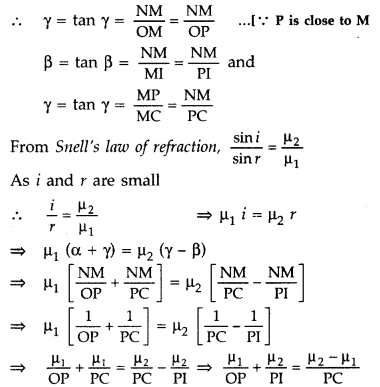
Using new Cartesian sign convention, we find
Object distance, OP = – u,
Image distance, PI = tv
Radius of curvature, PC = + R

Question 102.
Answer the following:
(i) Do the frequency and wavelength change when light passes from a rarer to a denser medium?
(ii) Why is the value of the angle of deviation for a ray of light undergoing refraction through a glass prism different for different colours of light? (Comptt. Delhi 2012)
Answer:
(i) Frequency remains same.
While wavelength changes by λ/m
(ii) Deviation produced by small angles prism,
![]()
Question 103.
Define power of a lens. Write its S.L units. Two thin convex lenses of focal lengths f
1
and f
2
are placed in contact coaxially. Derive the expression for the effective focal length of the combination. (Comptt. Delhi 2012)
Answer:
Power of a lens is defined as the ability to converge a beam of light facing on the lens
![]()
Its S.I. unit is dioptre (D)
Let C
1
, C
2
be the optical centres of two thin convex lenses L
1
and L
2
held co-axially in contact with each other in air.
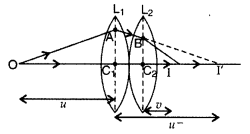
Suppose f
1
and f
2
are their respective focal lengths Let a point object O be placed on the common principal axis at a distance OC
1
= u
The lens L
1
alone would form its image at I’ where C
1
I’ = v’
From the lens formula for L
1
,

I’ would serve as a virtual object for lens L
2
, which forms a final image I at a distance of
C
1
I = v
As the lenses are thin, therefore, for the lens L
2
,
u = i
2
I’ = C
1
I’ = v’
From the lens formula for L
2
,
![]()
Adding equations (i) and {ii), we get
![]()
Let the two lenses be replaced by a single lens of focal length f which forms image I at distance v, of an object at distance u from the lens

Question 104.
Draw a ray diagram showing the path of a ray of light entering through a triangular glass prism. Deduce the expression for the refractive index of glass prism in terms of the angle of minimum deviation and angle of the prism. (Comptt. All India 2012)
Answer:
A ray PQ is incident on the face AB of prism at ∠i and effected along QR at ∠r. The angle of incidence (from glass to air) to the second face is Y and the angle of refraction or emergence is i’.
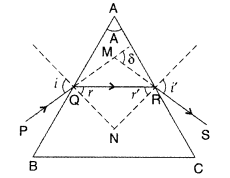
The angle between the emergent ray RS and incident ray in the direction PQ is called the angle of deviation δ.
In the quadrilateral AQNR,
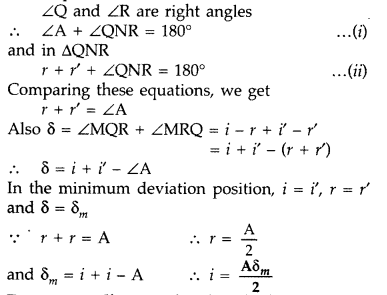
Question 105.
Draw a ray diagram showing the image formation by a compound microscope when the final image is formed at the near point.
Define the resolving power of a microscope. Write two factors by which resolving power can be increased. (Comptt. All India 2012)
Answer:
(a) Ray diagram of a compound microscope : A schematic diagram of a compound microscope is shown in the figure. The lens nearest the object, called the objective, forms a real, inverted, magnified image of the object. This serves as the object for the second lens, the eyepiece, which functions essentially like a simple microscope or magnifier, produces the final image, which is enlarged and virtual. The first inverted image is thus near (at or within) the focal plane of the eyepiece, at a distance appropriate for final image formation at infinity, or a little closer for image formation at the near point. Clearly, the final image is inverted with respect to the original object.

Magnification due to a compound microscope.
The ray diagram shows that the (linear) magnification due to the objective, namely h’/h, equals

Here h’ is the size of the first image, the object size being h and f
0
being the focal length of the objective. The first image is formed near the focal point of the eyepiece. The distance L, i.e., the distance between the second focal point of the objective and the first focal point of the eyepiece (focal length f
e
) is called the tube length of the compound microscope.
As the first inverted image is near the focal point of the eyepiece, we use for the simple microscope to obtain the (angular) magnification me due to it when the final image is formed at the near point, is
![]()
When the final image is formed at infinity, the angular magnification due to the eyepiece, me = (D//e)
![]()
Thus, the total magnification from equation (i) and (iii), when the image is formed at infinity, is
![]()
(b) Resolving power of a microscope :
![]()
(i) The focal length of the objective lens has no effect on the resolving power of microscope.
(ii) When the wavelength of light is increased, the resolving power of a microscope
![]()
Definition of resolving power: Resolving power of compound microscope is defined as reciprocal of the smallest distance between two point objects at which they can be just resolved when seen through microscope.
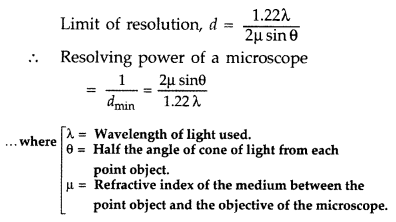
It can be increased by
- increasing the diameter of objective lens upto a certain limit; “
- using light of smaller wavelength.
- having a medium of higher refractive index.
Question 106.
Draw a ray diagram to show the formation of image by an astronomical telescope when the final image is formed at the near point. Answer the following, giving reasons:
(i) Why the objective has a larger focal length and a larger aperture than the eyepiece?
(ii) What would be the effect on the resolving power of the telescope if its objective lens is immersed in a transparent medium of higher refractive index?(Comptt. All India 2012)
Answer:

- Objective of larger focal length and large aperture gives higher magnification.
- Resolving power will increase.
Question 107.
Draw a labelled ray diagram of a refracting telescope. Define its magnifying power and write the expression for it.
Write two important limitations of a refracting telescope over a reflecting type telescope. (All India 2013)
Answer:
Refracting telescope :

Magnifying power. It is defined as the ratio of angle (β) subtended by the final image on the eye to the angle (α) subtended by object on eye.

Limitations of refracting telescope over a a reflecting type telescope :
- It suffers from chromatic aberration due to refraction and hence the image obtained is multicoloured and blurred.
- As a lens of large apparatus can’t be manufactured easily, its light gathering power is low and hence can’t be used to see faint stars.
Question 108.
A small bulb (assumed to be a point source) is placed at the bottom of a tank containing water to a depth of 80 cm. Find out the area of the surface of water through which light from the bulb can emerge. Take the value of the refractive index of water to be 4/3. (Comptt. Delhi 2013)
Answer:
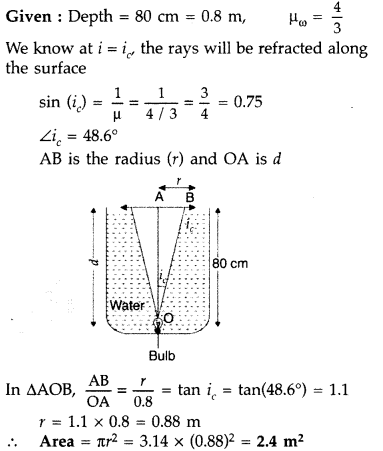
Question 109.
(a) A small telescope has an objective lens of focal length 140 cm and an eye-piece of focal length 5.0 cm. Find the magnifying power of the telescope for viewing distant objects when
(i) the telescope is in normal adjustment,
(ii) the final image is formed at the least distance of distinct vision.
(b) Also find the separation between the objective lens and the eye-piece. (Comptt. All India 2013) Answer:
(a) (i) For normal adjustment :
![]()
(ii) When the final image is formed at the least distance of distinct vision,

(b)
(i) For normal adjustment separation = (f
0
+ f
e
)
(ii) For least distance of distinct vision
Question 110.
An equiconvex lens of refractive index µ
1
, focal length ‘f’ and radius of curvature ‘R’ is immersed in a liquid of refractive index µ
2
. For
(i) µ
2
µ
1
, and
(ii) µ
2
< µ
1
, draw the ray diagrams in the two cases when a beam of light coming parallel to the principal axis is incident on the lens. Also find the focal length of the lens in terms of the original focal length and the refractive index of the glass of the lens and that of the medium.
(Comptt. All India 2013)
Answer:
(i) The ray diagrams are as shown below:
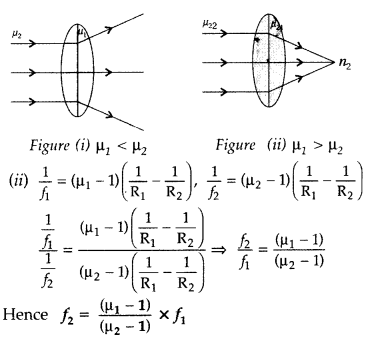
Question 111.
(a) Draw a labelled ray diagram showing the formation of a final image by a compound microscope at least distance of distinct vision.
(b) The total magnification produced by a compound microscope is 20. The magnification produced by the eye piece is 5. The microscope is focussed on a certain object. The distance between the objective and the eyepiece is observed to be 14 cm. If least distance of distinct vision is 20 cm, calculate the focal length of the objective and the eye piece. (Delhi 2014)
Answer:
(a) Ray diagram of a compound microscope : A schematic diagram of a compound microscope is shown in the figure. The lens nearest the object, called the objective, forms a real, inverted, magnified image of the object. This serves as the object for the second lens, the eyepiece, which functions essentially like a simple microscope or magnifier, produces the final image, which is enlarged and virtual. The first inverted image is thus near (at or within) the focal plane of the eyepiece, at a distance appropriate for final image formation at infinity, or a little closer for image formation at the near point. Clearly, the final image is inverted with respect to the original object.

Magnification due to a compound microscope.
The ray diagram shows that the (linear) magnification due to the objective, namely h’/h, equals

Here h’ is the size of the first image, the object size being h and f
0
being the focal length of the objective. The first image is formed near the focal point of the eyepiece. The distance L, i.e., the distance between the second focal point of the objective and the first focal point of the eyepiece (focal length f
e
) is called the tube length of the compound microscope.
As the first inverted image is near the focal point of the eyepiece, we use for the simple microscope to obtain the (angular) magnification me due to it when the final image is formed at the near point, is
![]()
When the final image is formed at infinity, the angular magnification due to the eyepiece, me = (D//e)
![]()
Thus, the total magnification from equation (i) and (iii), when the image is formed at infinity, is
![]()
(b) Resolving power of a microscope :
![]()
(i) The focal length of the objective lens has no effect on the resolving power of microscope.
(ii) When the wavelength of light is increased, the resolving power of a microscope
![]()
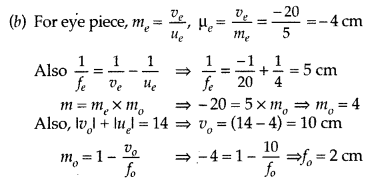
Hence Focal length of objective = 3.5 cm and Focal length of eyepiece = 5 cm
Question 112.
(a) A mobile phone lies along the principal axis of a concave mirror. Show, with the help of a suitable diagram, the formation of its image. Explain why magnification is not uniform.
(b) Suppose the lower half of the concave mirror’s reflecting surface is covered with an opaque material. What effect will this have on the image of the object? Explain (Delhi 2014)
Answer:
(a) The formation of image is shown in the
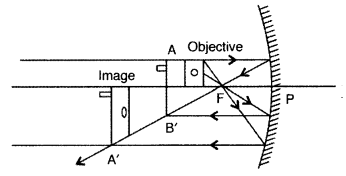
The magnification is not uniform and image is distorted because of the reason that the parts of mobile are situated at different distances from the mirror.
(b) When lower half of the concave mirror’s reflecting surface is covered with an opaque material, the image will be of the whole object, i.e. mobile. However, as the area of the reflecting surface has been reduced, the intensity of image (brightness) will be reduced to half.
Question 113.
A convex lens of focal length 20 cm is placed coaxially with a convex mirror of radius of curvature 20 cm. The two are kept at 15 cm from each other. A point object lies 60 cm in front of the convex lens. Draw a ray diagram to show the formation of the image by the combination. Determine the nature and position of the image formed.
Answer:
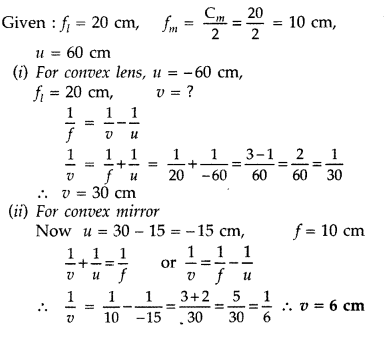
The image I
1
is formed behind the mirror and acts as a virtual object for the convex mirror; and finally image I
2
is formed, which is virtual between focus and pole of mirror.
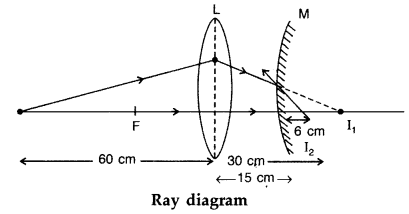
Question 114.
A convex lens of focal length 20 cm is placed coaxially with a concave mirror of focal length 10 cm at a distance of 50 cm apart from each other. A beam of light coming parallel to the principal axis is incident on the convex lens. Find the position of the final image formed by this combination. Draw the ray diagram showing the formation of the image. (All India 2014)
Answer:
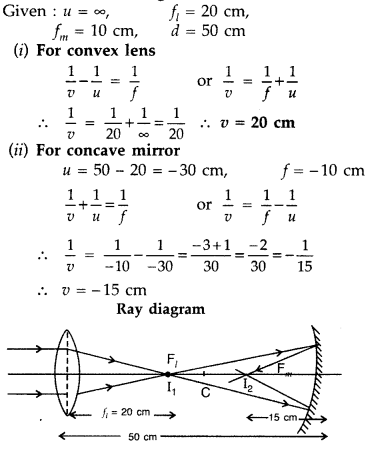
Final image is real and lies between F and C of concave mirror.
Question 115.
A convex lens of focal length 20 cm is placed coaxially with a convex mirror of radius of curvature 20 cm. The two are kept 15 cm apart. A point object is placed 40 cm in front of the convex lens. Find the position of the image formed by this combination. Draw the ray diagram showing the image formation. (All India 2014)
Answer:
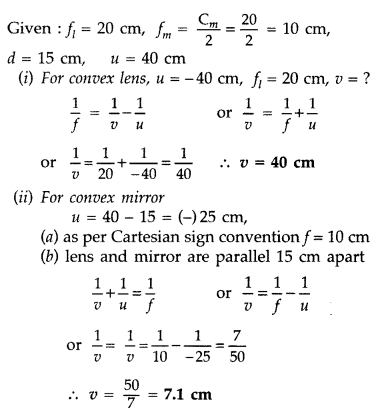
The final image is virtual and lies between pole and focus of convex mirror.
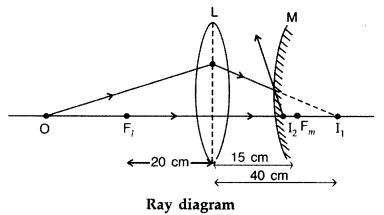
Question 116.
A ray PQ is incident normally on the face AB of a triangular prism of refracting angle of 60°, made of a transparent material of refractive index \(2 / \sqrt{3}\), as shown in the figure. Trace the path of the ray as it passes through the prism. Also calculate the angle of emergence and angle of deviation. (Comptt. Delhi 2014)
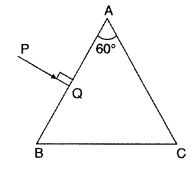
Answer:
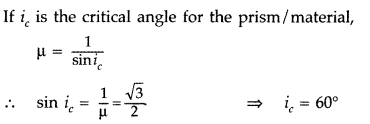
Angle of incidence at face AC of the prism = 60°
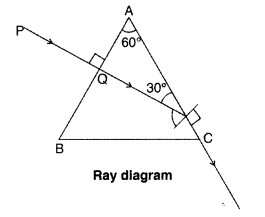
Hence, refracted ray grazes the surface AC as i
c
= i
∴ Angle of emergence = 90°
and Angle of deviation = 30°
Question 117.
(i) A giant refracting telescope has an objective lens of focal length 15 m. If an eye piece of focal length 1.0 cm is used, what is the angular magnification of the telescope?
(ii) If this telescope is used to view the moon, what is the diameter of the image of the moon formed by the objective lens? The diameter of the moon is 3.48 × 10
6
m and the radius of lunar orbit is 3.8 × 10
8
m. (Delhi 2015)
Answer:
(i) Let : f
0
= focal length of objective lens = 15 cm
f
e
= focal length of eye lens = 1.0 cm
Angular magnification (m)
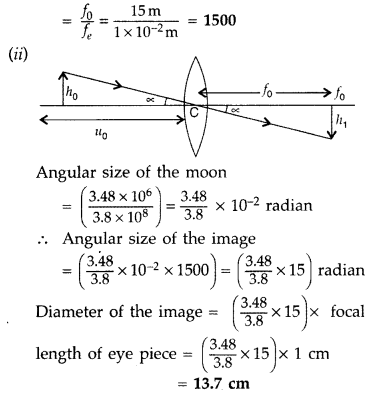
Question 118.
Define the term ‘critical angle’ for a pair of media.
A point source of monochromatic light ‘S’ is kept at the centre of the bottom of a cylinder of radius 15.0 cm. The cylinder contains water (refractive index 4/3) to a height of 7.0 cm. Draw the ray diagram and calculate the area of water surface through which the light emerges in air.
Answer:
(a) Critical Angle : For an incident ray, travelling from an optically denser medium to optically rarer medium, the angle of incidence, for which angle of refraction is \(90^{\circ}\), is called the critical Angle.
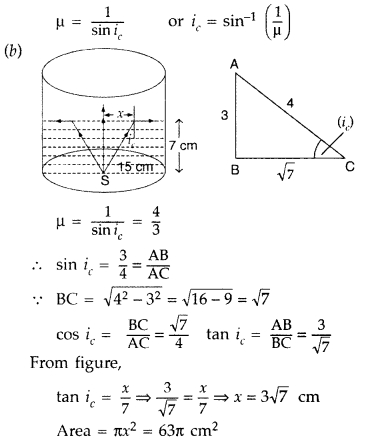
∴ The Area of water surface through which the light emerges in air is 63π m
2
Question 119.
Which two of the following L
1
, L
2
and L
3
will you select as objective and eyepiece for constructing best possible
(i) telescope
(ii) microscope? Give reason to support your answer. (Comptt. Delhi 2015)

Answer:
(i) Telescope : L
2
: objective, L
3
= eyepiece
Reason : Light gathering power magnifying power will be larger.
(ii) Microscope : L
3
: objective, L
1
= eyepiece
Reason : Angular magnification is more for short focal length of objective and eyepiece.
Question 120.
(a) Write the factors by which the resolving power of a telescope can be increased.
(b) Estimate the angular separation between first order maximum and third order minimum of the diffraction pattern due to a single slit of width 1 mm, when light of wavelength 600 nm is incident normal on it. (Comptt. All India 2015)
Answer:
(a) Factors for increasing the resolving power of telescope : The resolving power of a telescope is given by,
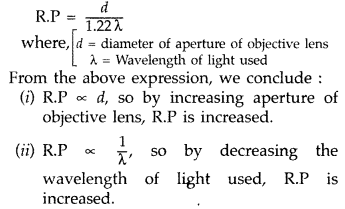
(iii) Resolving power is independent of focal length of objective lens.
(b) Given : a = 1 mm = 1 × 10
-3
m,
λ = 600 nm = 600 × 10
-9
m
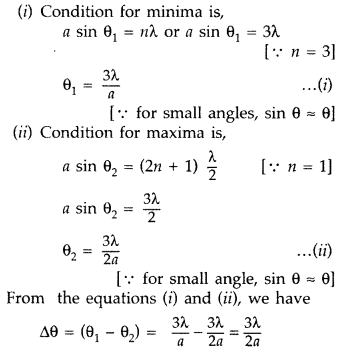
Putting the value of λ and a, we have

Question 121.
(a) Calculate the distance of an object of height ‘h’ from a concave mirror of radius of curvature 20 cm, so as to obtain a real image of magnification 2. Find the location of image also.
(b) Using mirror formula, explain why does a convex mirror always produce a virtual image. (Delhi 2016)
Answer:
(a) Given : R = -20 cm and magnification
m = -2
Focal length of the mirror f = \(\frac{\mathrm{R}}{2}\) = -10 cm
Magnification (m) = \(-\frac{v}{u}\)
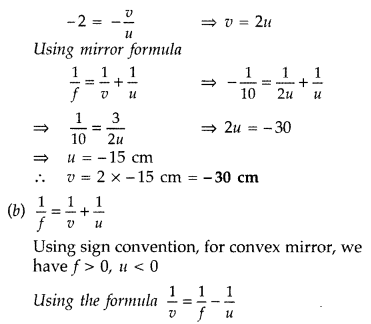
∴ f is positive and u is negative,
⇒ v is always positive, hence image is always virtual.
Question 122.
Draw a schematic ray diagram of reflecting telescope showing how rays coming from a distant object are received at the eye-piece. Write its two important advantages over a refracting telescope. (Delhi 2016)
Answer:
Reflecting telescope. Telescope with mirror objectives is called reflecting telescope. This is also known as Cassegrain telescope / Newtonian telescope. The ray diagram of reflecting type telescope is shown in figure.

Advantage over refracting telescope :
- Since reflecting telescope has mirror objective, so the image formed is free from chromatic aberration.
- Since the spherical mirrors are parabolic mirrors, free from spherical aberration, they produce a very sharp and distinct image.
Question 123.
Explain the following, giving reasons :
(i) When monochromatic light is incident on a surface separating two media, the reflected and refracted light both have the same frequency as the incident frequency.
(ii) When light travels from a rarer to a denser medium, the speed decreases. Does this decrease in speed imply a reduction in the energy carried by the wave?
(iii) In the wave picture of light, intensity of light is determined by the square of the amplitude of the wave. What determines the intensity in the photon picture of light? (All India 2016)
Answer:
(i) Reflection and refraction arise through interaction of incident light with atomic constituents of matter which vibrate with the same frequency as that of the incident light. Hence frequency of reflected and refracted light both have the same frequency as the incident frequency.
(ii) No, energy carried by a wave depends on the amplitude of the wave and not on the speed of wave propagation.
(iii) For a given frequency, intensity of light in the photon picture is determined by the number of photons incident normally on crossing a unit area per unit time.
Question 124.
A convex lens, of focal length 25 cm, and a convex mirror, of radius of curvature 20 cm, are placed co-axially 40 cm apart from each other. An incident beam, parallel to the principal axis, is incident on the convex lens. Find the position and nature of the image formed by this combination. (Comptt. All India 2016)
Answer:
The given ‘setup’ is as shown
The object, being at infinity, the image formed by the convex lens, is at its focus, i.e. 25 cm from the lens. This image becomes the ‘object’ for convex mirror.
Now, for the convex mirror
Object distance = (40 – 25) cm = 15 cm
Radius of curvature, R = 20 cm
u = -15 cm, R = +20 cm
Using the mirror formula :
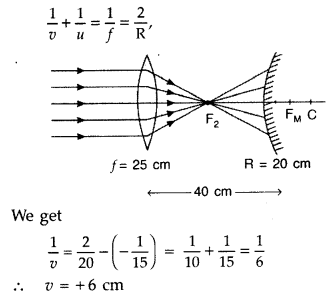
The final image is, therefore, a vitrual image that appears to be formed (behind the convex mirror) at a distance of 6 cm from it.
Question 125.
(i) A ray of light incident on face AB of an equilateral glass prism, shows minimum deviation of 30°. Calculate the speed of light through the prism.
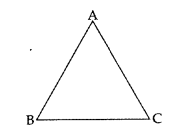
(ii) Find the angle of incidence at face AB so that the emergent ray grazes along the face AC. (Delhi 2016)
Answer:
(i) Given : For equilateral glass prism ∠A = 60°, ∠δm = 30°
We know
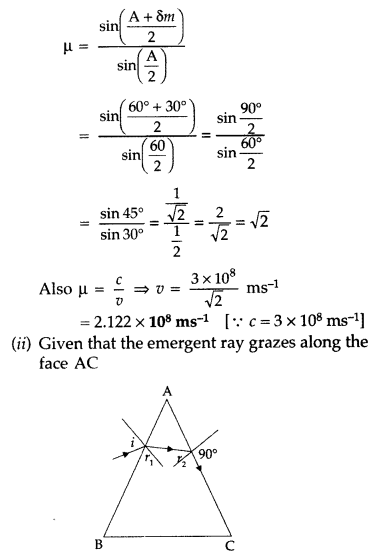
At face AC, let the angle of incidence be r
2
For grazing ray e = 90°
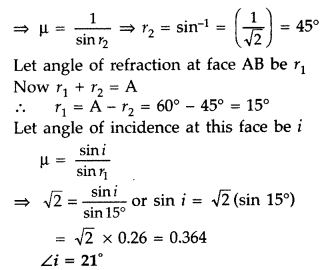
Question 126.
(a) Monochromatic light of wavelength 589 nm is incident from air on a water surface. If p for water is 1.33, find the wavelength, frequency and speed of the refracted light.
(b) A double convex lens is made of a glass of refractive index 1.55, with both faces of the same radius of curvature. Find the radius of curvature required, if the focal length is 20 cm. (All India 2017)
Answer:
(a) Given : Wavelength of monochromatic
light, λ = 589 nm = 589 × 10
-9
m,
Refractive index of water, µ = 1.33,
Speed of light in air, c = 3 × 10
8
ms
-1
Frequency of light does not depend on the property of the medium in which it is travelling. Hence, the frequency of the emergent ray in water will be equal to the frequency of the incident or emergent light in air.

Speed of light in water is related to the refractive index of water, as :
![]()
Wavelength of light in water is given by the relation,
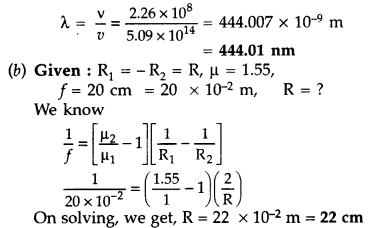
Question 127.
(a) Draw a ray diagram depecting the formation of the image by an astronomical telescope in normal adjustment.
(b) You are given the following three lenses. Which two lenses will you use as an eyepiece and as an objective to construct an astronomical telescope? Give reason. (All India 2017)
| Lenses | Power (D) | Aperture (cm) |
| L 1 | 3 | 8 |
| L 2 | 6 | 1 |
| L 3 | 10 | 1 |
Answer:
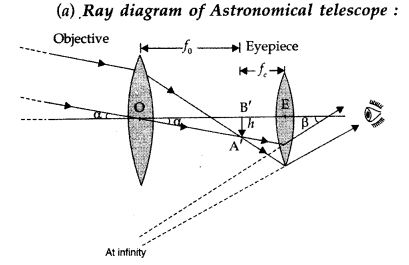
(b) Objective Lens : Lens L
1
Eyepiece Lens : Lens L
2
Reason : The objective should have large aperture and large focal length; while the eyepiece should have small aperture and small focal length.
Question 128.
(a) Draw a ray diagram showing the formation of image by a reflecting telescope.
(b) Write two advantages of a reflecting telescope over a refracting telescope. (All India 2017)
Answer:
Reflecting telescope. Telescope with mirror objectives is called reflecting telescope. This is also known as Cassegrain telescope / Newtonian telescope. The ray diagram of reflecting type telescope is shown in figure.

Advantage over refracting telescope :
- Since reflecting telescope has mirror objective, so the image formed is free from chromatic aberration.
- Since the spherical mirrors are parabolic mirrors, free from spherical aberration, they produce a very sharp and distinct image.
Question 129.
(a) Draw a ray diagram for the formation of image by a compound microscope.
| Lenses | Power (D) | Aperture (cm) |
| L 1 | 3 | 8 |
| L 2 | 6 | 1 |
| L 3 | 10 | 1 |
(b) You are given the following three lenses. Which two lenses will you use as an eyepiece and as an objective to construct a compound microscope?
(c) Define resolving power of a microscope and write one factor on which it depends.
(All India)
Answer:
(a) Compound microscope :
(a) Ray diagram of a compound microscope : A schematic diagram of a compound microscope is shown in the figure. The lens nearest the object, called the objective, forms a real, inverted, magnified image of the object. This serves as the object for the second lens, the eyepiece, which functions essentially like a simple microscope or magnifier, produces the final image, which is enlarged and virtual. The first inverted image is thus near (at or within) the focal plane of the eyepiece, at a distance appropriate for final image formation at infinity, or a little closer for image formation at the near point. Clearly, the final image is inverted with respect to the original object.

Magnification due to a compound microscope.
The ray diagram shows that the (linear) magnification due to the objective, namely h’/h, equals

Here h’ is the size of the first image, the object size being h and f
0
being the focal length of the objective. The first image is formed near the focal point of the eyepiece. The distance L, i.e., the distance between the second focal point of the objective and the first focal point of the eyepiece (focal length f
e
) is called the tube length of the compound microscope.
As the first inverted image is near the focal point of the eyepiece, we use for the simple microscope to obtain the (angular) magnification me due to it when the final image is formed at the near point, is
![]()
When the final image is formed at infinity, the angular magnification due to the eyepiece, me = (D//e)
![]()
Thus, the total magnification from equation (i) and (iii), when the image is formed at infinity, is
![]()
(b) Objective : Lens L 3 Eyepiece : Lens L 2
(c)
Resolving power of a microscope :
![]()
- The focal length of the objective lens has no effect on the resolving power of microscope.
-
When the wavelength of light is increased, the resolving power of a microscope

Question 130.
An optical instrument uses eye-lens of power 16 D and objective lens of power 50 D and has a tube length of 16.25 cm. Name the optical instrument and calculate its magnifying power if it forms the final image at infinity. (Comptt. Delhi 2017)
Answer:
The optical instrument is Compound Microscope.
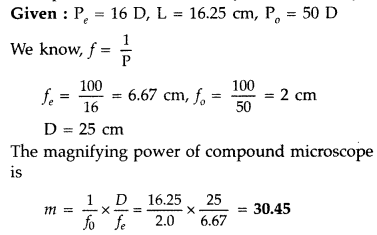
Question 131.
Answer the following questions:
(a) Plane and convex mirrors produce virtual images of objects. Can they produce real images under some circumstances? Explain
(b) A virtual image, we always say, cannot be caught on a screen. Yet when we ‘see’ a vitrual image, we are obviously bringing it on to the ‘screen’ (i.e. the retina) of our eye. Is there a contradiction?
(c) A diver under water, looks obliquely at a fisherman standing on the bank of a lake. Would the fisherman look taller or shorter to the diver than what he actually is?
(d) Does the apparatus depth of a tank of water change if viewed obliquely? If so, does the apparatus depth increase or decrease?
(e) The refractive index of diamond is much greater than that of ordinary glass. Is this fact of some use to a diamond cutter? (Comptt. Delhi 2017)
Answer:
(a) Rays converging to a point ‘behind’ a plane or convex mirror are reflected to a point in front of the mirror on a screen. In other words, a plane or convex mirror can produce a real image if the object is virtual. Convince yourself by drawing an appropriate ray diagram.
(b) When the reflected or refracted rays are divergent, the image is virtual. The divergent rays can be converged on to a screen by means of an appropriate converging lens. The convex lens of the eye does just that. The virtual image here serves as an object for the lens to produce a real image. Note, the screen here is not located at the position of the virtual image. There is no contradiction.
(c) Taller
(d) The apparent depth for oblique viewing decreases from its value for near-normal viewing. Convince yourself of this fact by drawing ray diagrams for different positions of the observer.
(e) Refractive index of a diamond is about 2.42, much larger than that of ordinary glass (about 1.5). The critical angle of diamond is about 24°, much less than that of glass. A skilled diamond-cutter exploits the larger range of angles of incidence (in the diamond), 24° to 90°, to ensure that light entering the diamond is totally reflected from many faces before getting out, thus producing a sparkling effect.
Question 132.
An optical instrument uses eye-lens of power 20 D and the objective lens of power 50 D. It has a tube length of 15 cm. Name the optical instrument and calculate its magnifying power if it forms the final image at infinity. (Comptt. Delhi 2017)
Answer:
The optical instrument is Compound Microscope.

Hint : Compound microscope, m = 37.5
Question 133.
An optical instrument uses eye-lens of power 12.5 D and object lens of power 50 D and has a tube length of 20 cm. Name the optical instrument and calculate its magnifying power, if it forms the final image at infinity. (Comptt. Delhi 2017)
Answer:
The optical instrument is Compound Microscope.

Hint : Compound microscope, m = 31.25
Ray Optics and Optical Instruments Class 12 Important Questions Long Short Answer Type
Question 134.
(a) For a ray of light travelling from a denser medium of refractive index n
1
to a rarer medium of refractive index n
2
, prove that \(\frac{n_{2}}{n_{1}}\), where i
c
is the critical angle of incidence for the media.
(b) Explain with the help of a diagram, how the above principle is used for transmission of video signals using optical fibres. (Delhi 2008)
Answer:
(a) When i = i
c
, r = 90°
Using Snell’s law of refraction : n
x
sin ic = n
2
sin 90°
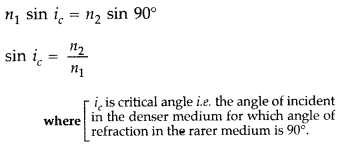
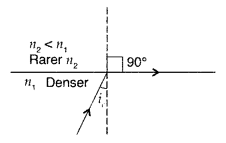
(b) When a video signal is directed into an optical fibre at a suitable angle, it undergoes internal reflections repeatedly along the length of the optical fibre and comes out of it with almost neglible loss of intensity.
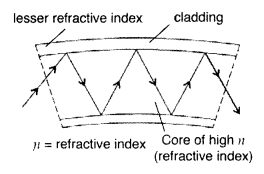
Question 135.
Derive the lens formula, \(\frac{1}{f}=\frac{1}{v}-\frac{1}{u}\) for a concave lens, using the necessary ray diagram. Two lenses of powers 10 D and – 5 D are placed in contact.
(a) Calculate the power of the new lens.
(b) Where should an object be held from the lens, so as to obtain a virtual image of magnification 2?
Answer:
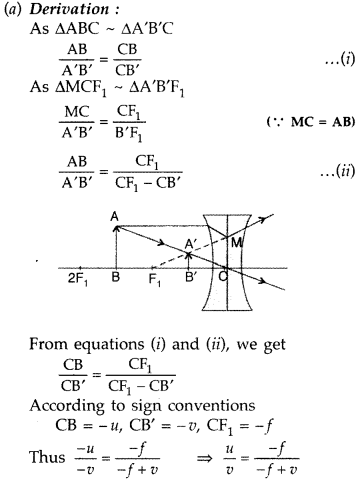
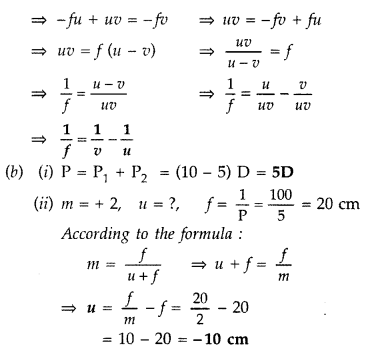
Question 136.
Trace the rays of light showing the formation of an image due to a point object placed on the axis of a spherical surface separating the two media of refractive indices n
1
and n
2
. Establish the relation between the distances of the object, the image and the radius of curvature from the central point of the spherical surface.
Hence derive the expression of the lens maker’s formula. (Delhi 2009)
Answer:
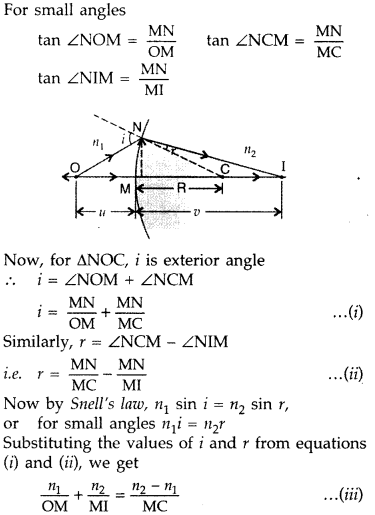
By applying Cartesian sign convention,
OM = -M, MI = -v, MC = +R
Substituting these values in (iii), we get
![]()
This equation gives us a relation between object and image distance in terms of refractive index of the medium and the radius of the curvature of the curved spherical surface. It holds for any curved spherical surface.
Lens maker’s formula:
(a) Lens maker’s formula : Consider a thin double convex lens of refractive index n
2
placed in a medium of refractive index n
1
. Here, n
1
< n
2
. Let B and D be the poles, C
1
and C
2
be the centres of curvature and R
1
and R
2
be the radii of curvature of the two lens surfaces ABC and ADC, respectively. For refraction at surface ABC, we can write the relation between the object distance u, image distance v
1
and radius of curvature R
1
as
![]()
For refraction at surface ADC, we can write the relation between the object distance v
1
, image distance v and radius of curvature R
2
, as
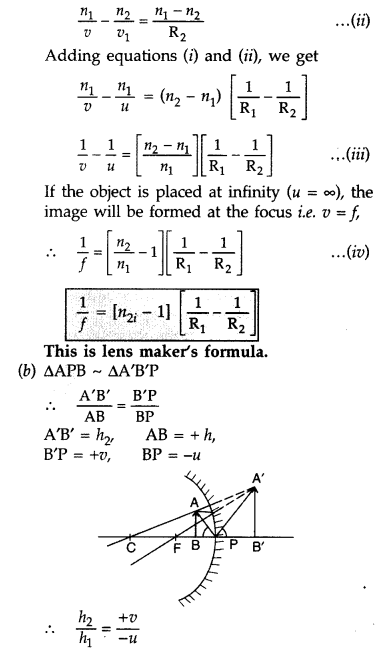
Question 137.
Draw the labelled ray diagram for the formation of image by a compound microscope.
Derive the expression for the total magnification of a compound microscope. Explain why both the objective and the eyepiece of a compound microscope must have short focal lengths.(Delhi 2009) Answer:
Compound Microscope :
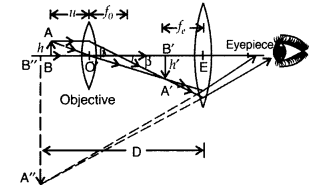
Magnifying power : The magnifying power of a compound microscope is defined as the ratio of the angle subtended at the eye by the final virtual image to the angle subtended at the eye by the object, when both are at the least distance of distinct vision from the eye.
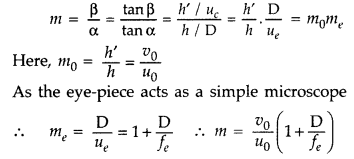
As the object AB is placed close to the focus f
0
of the objective
∴ u
0
= -f
o
Also image A’B’ is formed close to the eyelens whose focal length is short, therefore v
0
= L = the length of the microscope tube or the distance between the two lenses

(i) If the focal lengths are less, then their magnifying power will be more.
(ii) To avoid any aberrations in refraction due to larger bend on passing through the eye-piece.
Question 138.
(i) Draw a labelled ray diagram to show the formation of image in an astronomical telescope for a distant object.
(ii) Write three distinct advantages of a reflecting type telescope over a refracting type telescope.
(b) A convex lens of focal length 10 cm is placed coaxially 5 cm away from a concave lens of focal length 10 cm. If an object is placed 30 cm in front of the convex lens, find the position of the final image formed by the combined system. (All India 2009)
Answer:
(a)
(i) Magnifying power m = \(-\frac{f_{0}}{f_{e}}\). It does not change with increase of aperature of objective lens, because focal length of a lens has no concern with the aperature of lens.

(ii) Drawbacks :
- Images formed by these telescopes have chromatic aberrations.
- Lesser resolving power.
- The image formed is inverted and faintes.
(ii)

(ii) Advantages of reflecting telescope over a refracting telescope:
- Due to large aperture of the mirror used, the reflecting telescopes have high resolving power.
- This type of telescope is free from chromatic aberration (formation of coloured image of a white object).
- The use of paraboloidal mirror reduces the spherical aberration (formation of non-point, blurred image of a point object).
- Image formed by reflecting telescope is brighter than refracting telescope.
- A lens of large aperture tends to be very heavy and therefore difficult to make and support by its edges. On the other hand, a mirror of equivalent optical quality weights less and can be supported over its entire back surface.
(b) For convex lens :
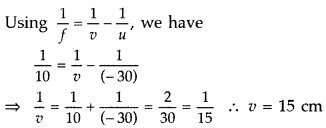
Since concave lens is at 5 cm distance, a virtual object for concave lens is said to be at a distance of 10 cm.
For concave lens :
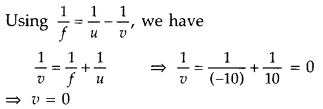
∴ Image will be at infinite distance or the ray will emerge parallel to the axis.
Question 139.
Draw a ray diagram to show the working of a compound microscope. Deduce an expression for the total magnification when the final image is formed at the near point.
In a compound microscope, an object is placed at a distance of 1.5 cm from the objective of focal length 1.25 cm. If the eye piece has a focal length of 5 cm and the final image is formed at the near point, estimate the magnifying power of the microscope. (Delhi 2010)
Answer:
Compound Microscope :

Magnifying power : The magnifying power of a compound microscope is defined as the ratio of the angle subtended at the eye by the final virtual image to the angle subtended at the eye by the object, when both are at the least distance of distinct vision from the eye.
Numerical:

The -ve sign shows that the final image is an inverted image.
Question 140.
(a) Obtain lens makers formula using the expression
![]()
Here the ray of light propagating from a rarer medium of refractive index (n
1
) to a denser medium of refractive index (n
2
) is incident on the convex side of spherical refracting surface of radius of curvature R.
(b) Draw a ray diagram to show the image formation by a concave mirror when the object is kept between its focus and the pole. Using this diagram, derive the magnification formula for the image formed. (Delhi 2011)
Answer:
(a) Lens maker’s formula : Consider a thin double convex lens of refractive index n
2
placed in a medium of refractive index n
1
. Here, n
1
< n
2
. Let B and D be the poles, C
1
and C
2
be the centres of curvature and R
1
and R
2
be the radii of curvature of the two lens surfaces ABC and ADC, respectively. For refraction at surface ABC, we can write the relation between the object distance u, image distance v
1
and radius of curvature R
1
as
![]()
For refraction at surface ADC, we can write the relation between the object distance v
1
, image distance v and radius of curvature R
2
, as


Question 141.
Define magnifying power of a telescope. Write its expression.
A small telescope has an objective lens of focal length 150 cm and an eyepiece of focal length 5 cm. If this telescope is used to view a 100 m high tower 3 km away, find the height of the final image when it is formed 25 cm away from the eyepiece. (Delhi 2012)
Answer:
The magnifying power of a telescope is defined as the ratio of the angle subtended at the eye by the final image formed at the least distance of distance vision to the angle subtended at the eye by the object at infinity, when seen directly
![]()
Angle substended by the 100 m tall tower at 3 km aways is,
![]()
Let h be the height of the image of tower formed by the objective.
Then angle subtended by the image produced by the objective will also be equal to h and is given by ‘
![]()
Magnification produced by the eyepiece

Question 142.
How is the working of a telescope different from that of a microscope?
The focal lengths of the objective and eyepiece of a microscope are 1.25 cm and 5 cm respectively. Find the position of the object relative to the objective in order to obtain an angular magnification of 30 in normal adjustment. (Delhi 2012)
Answer:
| Telescope | Microscope | |
| 1. | Resolving power should be higher for certain magnification. | Resolving power is not so large but the magnification should be higher. |
| 2. | Focal length of objective should be kept larger while eyepiece focal length should be small for better magnification. | Both objective and eyepiece should have less focal length for better magnification. |
| 3. | Objective should be of large aperture. | Eyepiece should be of large aperture. |
| 4. | Distance between objective and eyepiece is adjusted to focus the object at infinity. | Distance between objective and eyepiece is fixed, for focusing an object the distance of the objective is changed. |
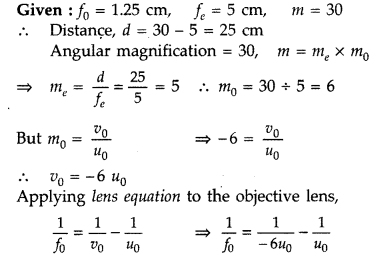
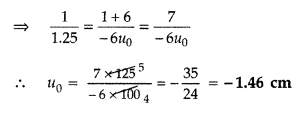
Question 143.
Draw a ray diagram showing the formation of the image by a point object on the principal axis of a spherical convex surface separating two media of refractive indices n
1
and n
2
, when a point source is kept in rarer medium of refractive index nv Derive the relation between object and image distance in terms of refractive index of the medium and radius of curvature of the surface.
Hence obtain the expression for Lens-maker’s formula in the case of thin convex lens. (Comptt. Delhi 2014)
Answer:

By applying Cartesian sign convention,
OM = -M, MI = -v, MC = +R
Substituting these values in (iii), we get
![]()
This equation gives us a relation between object and image distance in terms of refractive index of the medium and the radius of the curvature of the curved spherical surface. It holds for any curved spherical surface.
Lens maker’s formula:
(a) Lens maker’s formula : Consider a thin double convex lens of refractive index n
2
placed in a medium of refractive index n
1
. Here, n
1
< n
2
. Let B and D be the poles, C
1
and C
2
be the centres of curvature and R
1
and R
2
be the radii of curvature of the two lens surfaces ABC and ADC, respectively. For refraction at surface ABC, we can write the relation between the object distance u, image distance v
1
and radius of curvature R
1
as
![]()
For refraction at surface ADC, we can write the relation between the object distance v
1
, image distance v and radius of curvature R
2
, as
 >
>
Question 144.
(a) A point object is placed in front of a double convex lens (of refractive index n = n2/n1 with respect to air) with its spherical faces of radii of curvature R
1
and R
2
. Show the path of rays due to refraction at first and subsequently at the second surface to obtain the formation of the real image of the object.
Hence obtain the Lens-maker’s formula for a thin lens.
(b) A double convex lens having both faces of the same radius of curvature has refractive index 1-55. Find out the radius of curvature of the lens required to get the focal length of 20 cm. (Comptt. All India)
Answer:
(a) Lens-maker’s formula. The image of point object O is formed in two steps. The first reflecting surface ‘c
1
forms the image I
1
of the object O. The image I
1
acts as a virtual object for formation of image I by the second surface ‘c
2
‘.
For the first surface ABC ‘c
1
‘,
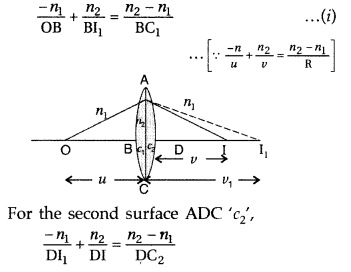
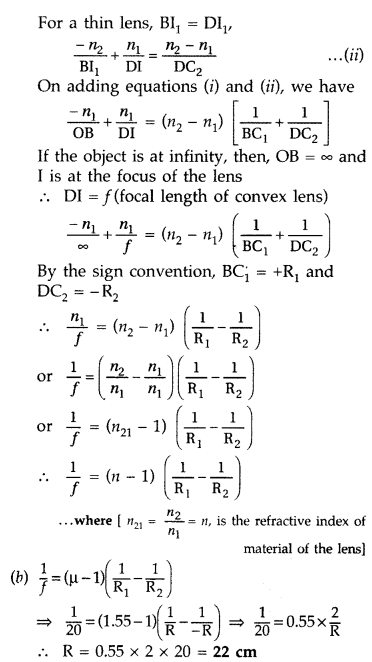
Question 145.
(a) Draw a labelled ray diagram showing the image formation of a distant object by a refracting telescope.
Deduce the expression for its magnifying power when the final image is formed at infinity.
(b) The sum of focal lengths of the two lenses of a refracting telescope is 105 cm. The focal length of one lens is 20 times that of the other. Determine the total magnification of the telescope when the final image is formed at infinity. (Comptt. All India 2015)
Answer:
(a) Refracting telescope :

Magnifying power. It is defined as the ratio of angle (β) subtended by the final image on the eye to the angle (α) subtended by object on eye.

Limitations of refracting telescope over a a reflecting type telescope :
- It suffers from chromatic aberration due to refraction and hence the image obtained is multicoloured and blurred.
- As a lens of large apparatus can’t be manufactured easily, its light gathering power is low and hence can’t be used to see faint stars.
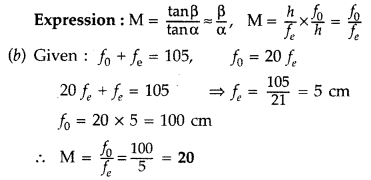
Question 146.
(a) A ray ‘PQ’ of light is incident on the face AB of a glass prism ABC (as shown in the figure) and emerges out of the face AC. Trace the path of the ray. Show that
∠i + ∠e = ∠A + ∠δ
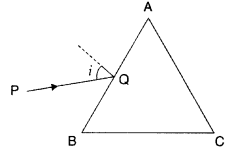
where δ and e denote the angle of deviation and angle of emergence respectively.
Plot a graph showing the variation of the angle of deviation as a function of angle of incidence. State the condition under which ∠δ is minimum.
(b) Find out the relation between the refractive index (µ) of the glass prism and ∠A for the case when the angle of prism (A) is equal to the angle of minimum deviation (δ
m
). Hence obtain the value of the refractive index for angle of prism A = 60°. (All India 2015)
Answer:
(a) The figure shows the passage of light through a triangular prism ABC. The angles of incidence and refraction at the first face AB are i and rv while the angle of incidence (from glass to air) at the second face AC is r
2
and the angle of refraction or emergence e. The angle between the emergent ray RS and the direction of the incident ray PQ is called the angle of deviation δ.
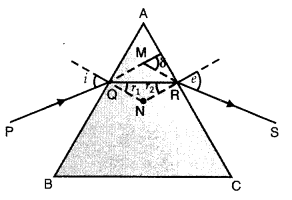
In the quadrilateral AQNR, two of the angles (at the vertices Q and R) are right angles. Therefore, the sum of the other angles of the quadrilateral is 180°.
![]()
From the triangle
![]()
Comparing these two equations, we get
r
1
+ r
2
= A
The total deviation 8 is the sum of deviations at the two faces,

A plot between the angle of deviation and angle of incidence is shown in the figure. In general, any given value of δ, except for i = e, corresponds to two values i and hence of e. This, in fact, is expected from the symmetry of i and e in equation (i) above, i.e., δ remains the same if i and e are. interchanged. Physically, this is related to the fact that the path of ray in the diagram above can be traced back, resulting in the same angle of deviation. At the minimum deviation dm, the refracted ray inside the prism becomes parallel to its base. We have,
![]()
When angle of incidence (i) and angle of emergence (e) are equal, ie,
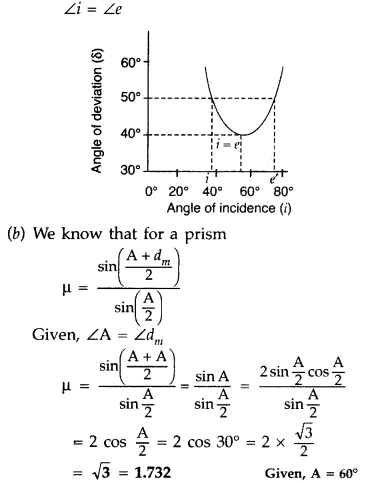
Question 147.
(a) Draw a ray diagram showing the image formation by a compound microscope. Obtain expression for total magnification when the images is formed at infinity.
(b) How does the resolving power of a compound microscope get affected, when
(i) focal length of the objective is decreased.
(ii) the wavelength of light is increased? Give reasons to justify your answer.
Answer:
(a) Ray diagram of a compound microscope : A schematic diagram of a compound microscope is shown in the figure. The lens nearest the object, called the objective, forms a real, inverted, magnified image of the object. This serves as the object for the second lens, the eyepiece, which functions essentially like a simple microscope or magnifier, produces the final image, which is enlarged and virtual. The first inverted image is thus near (at or within) the focal plane of the eyepiece, at a distance appropriate for final image formation at infinity, or a little closer for image formation at the near point. Clearly, the final image is inverted with respect to the original object.

Magnification due to a compound microscope.
The ray diagram shows that the (linear) magnification due to the objective, namely h’/h, equals

Here h’ is the size of the first image, the object size being h and f
0
being the focal length of the objective. The first image is formed near the focal point of the eyepiece. The distance L, i.e., the distance between the second focal point of the objective and the first focal point of the eyepiece (focal length f
e
) is called the tube length of the compound microscope.
As the first inverted image is near the focal point of the eyepiece, we use for the simple microscope to obtain the (angular) magnification me due to it when the final image is formed at the near point, is
![]()
When the final image is formed at infinity, the angular magnification due to the eyepiece, me = (D//e)
![]()
Thus, the total magnification from equation (i) and (iii), when the image is formed at infinity, is
![]()
(b) Resolving power of a microscope :
![]()
(i) The focal length of the objective lens has no effect on the resolving power of microscope.
(ii) When the wavelength of light is increased, the resolving power of a microscope
![]()
Question 148.
(a) A point object ‘O’ is kept in a medium of refractive index n
1
in front of a convex spherical surface of radius of curvature R which separates the second medium of refractive index n
2
from the first one, as shown in the figure.
Draw the ray diagram showing the image formation and deduce the relationship between the object distance and the image distance in terms of n
1
n
2
and R.
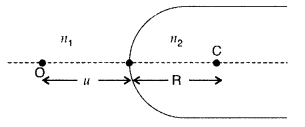
(b) When the image formed above acts as a virtual object for a concave spherical surface separating the medium n
2
from n
2
(n
2
> n
1
), draw this ray diagram and write the similar [similar to (a)] relation. Hence obtain the expression for the lens maker’s formula. (Delhi 2015)
Answer:
(a) For small angles
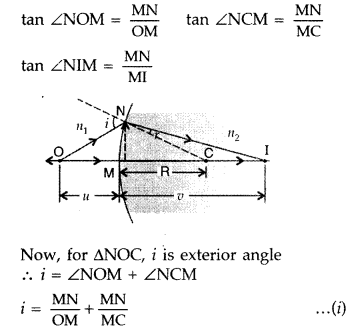
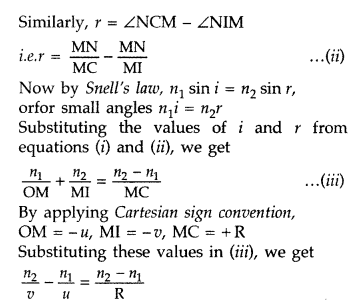
This equation gives us a relation between object and image distance interms of refractive index of the medium and the radius of the curvature of the curved Spherical surface. It holds for any curved Spherical surface.
(b) Len’s maker’s formula : Consider a thin double convex lens of refractive index n 2 placed in a medium of refractive index n 1 .
Here n 1 < n 2 . Let B and D be the poles, C 1 and C 2 be the centres of curvature R 1 and R 2 be the radii of curvature of the two lens surfaces ABC and ADC, respectively.
For refraction at surface ABC, we can write the relation between the object distance u, image distance v
1
and radius of curvature R
1
as
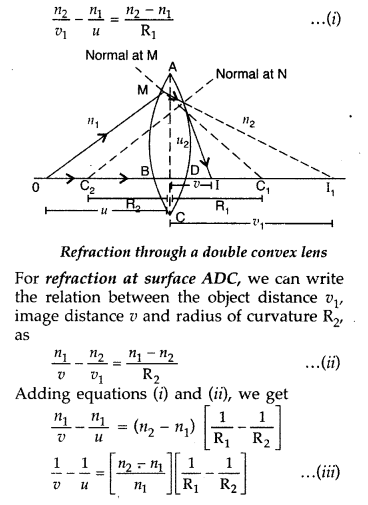
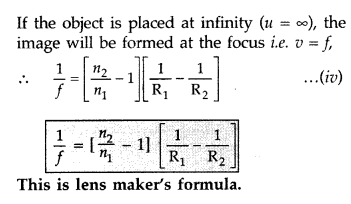
Question 149.
(i) Plot a graph to show variation of the angle of deviation as a function of angle of incidence for light passing through a prism. Derive an expression for refractive index of the prism in terms of angle of minimum deviation and angle of prism.
(ii) What is dispersion of light? What is its cause?
(iii) A ray of light incident normally on one face of a right isosceles prism is totally reflected as shown in figure. What must be the minimum value of refractive index of glass? calculations.
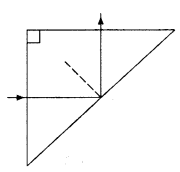
Answer:
(i)
(a) The figure shows the passage of light through a triangular prism ABC. The angles of incidence and refraction at the first face AB are i and rv while the angle of incidence (from glass to air) at the second face AC is r2 and the angle of refraction or emergence e. The angle between the emergent ray RS and the direction of the incident ray PQ is called the angle of deviation δ.

In the quadrilateral AQNR, two of the angles (at the vertices Q and R) are right angles. Therefore, the sum of the other angles of the quadrilateral is 180°.
![]()
From the triangle
![]()
Comparing these two equations, we get
r
1
+ r
2
= A
The total deviation 8 is the sum of deviations at the two faces,

A plot between the angle of deviation and angle of incidence is shown in the figure. In general, any given value of δ, except for i = e, corresponds to two values i and hence of e. This, in fact, is expected from the symmetry of i and e in equation (i) above, i.e., δ remains the same if i and e are. interchanged. Physically, this is related to the fact that the path of ray in the diagram above can be traced back, resulting in the same angle of deviation. At the minimum deviation dm, the refracted ray inside the prism becomes parallel to its base. We have,
![]()
When angle of incidence (i) and angle of emergence (e) are equal, ie,

(ii) The white light disperses when passed through a prism, because the refractive index of the glass of the prism is different for different wavelength (colours). Hence, different colours get bent along different directions.
(iii) For total internal reflection, Zi > Zi (critical angle)
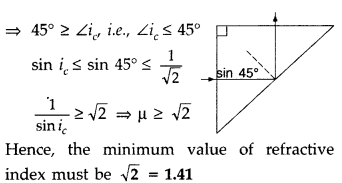
Hence, the minimum value of refractive index must be \(\sqrt{2}\) = 1.41
Question 150.
(i) Derive the mathematical relation between refractive indices n
1
and n
2
of two radii and radius of curvature R for refraction at a convex spherical surface. Consider the object to be a point since lying on the principle axis in rarer medium of refractive index n
1
and a real image formed in the denser medium of refractive index n
2
.
Hence, derive lens maker’s formula.
(ii) Light from a point source in air falls on a convex spherical glass surface of refractive index 1.5 and radius of curvature 20 cm. The distance of light source from the glass surface is 100 cm. At what position is the image formed?
Answer:
(a) For small angles


This equation gives us a relation between object and image distance interms of refractive index of the medium and the radius of the curvature of the curved Spherical surface. It holds for any curved Spherical surface.
(b) Len’s maker’s formula : Consider a thin double convex lens of refractive index n 2 placed in a medium of refractive index n 1 .
Here n 1 < n 2 . Let B and D be the poles, C 1 and C 2 be the centres of curvature R 1 and R 2 be the radii of curvature of the two lens surfaces ABC and ADC, respectively.
For refraction at surface ABC, we can write the relation between the object distance u, image distance v
1
and radius of curvature R
1
as


⇒ v = 100 cm a real image on the other side, 100 cm away from the surface.
Question 151.
(a) Draw a labelled ray diagram to obtain the real image formed by an astronomical telescope in normal adjustment position. Define its magnifying power.
(b) You are given three lenses of power 0.5 D, 4 D and 10 D to design a telescope.
(i) Which lenses should be used as objective and eyepiece? Justify your answer.
(ii) Why is the aperture of the objective preferred to be large? (All India 2016)
Answer:
(a)
(i) Magnifying power m = \(-\frac{f_{0}}{f_{e}}\). It does not change with increase of aperature of objective lens, because focal length of a lens has no concern with the aperature of lens.

(ii) Drawbacks :
- Images formed by these telescopes have chromatic aberrations.
- Lesser resolving power.
- The image formed is inverted and faintes.
(b) Definition : It is the ratio of the angle subtended at the eye, by the final image, to the angle which the object subtends at the lens, or the eye.
(i) Objective = 0.5 D and eye lens = 10 D
∵ This choice would give higher

(ii) High resolving power/Brighter image/ lower limit of resolution.
Question 152.
(a) A point object, O is on the principal axis of a spherical surface having a radius of curvature, R. Draw a diagram to obtain the relation between the object and image distances, the refractive indices of the media and the radius of curvature of the spherical surface.
(b) Write the Lens Maker’s formula and use it to obtain the range of values of µ (the refractive index of the material of the lens) for which the focal length of an equiconvex lens, kept in air, would have a greater magnitude than that of the radius of curvature of its two surfaces. (Comptt. Delhi 2016)
Answer:
(a) For small angles


This equation gives us a relation between object and image distance interms of refractive index of the medium and the radius of the curvature of the curved Spherical surface. It holds for any curved Spherical surface.
(b) Len’s maker’s formula : Consider a thin double convex lens of refractive index n 2 placed in a medium of refractive index n 1 .
Here n 1 < n 2 . Let B and D be the poles, C 1 and C 2 be the centres of curvature R 1 and R 2 be the radii of curvature of the two lens surfaces ABC and ADC, respectively.
For refraction at surface ABC, we can write the relation between the object distance u, image distance v
1
and radius of curvature R
1
as


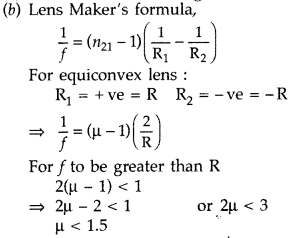
Hence required range is 1.0 < µ < 1.5
Question 153.
The relation, between the angle of incidence
(i) and the corresponding, angle of deviation (δ), for a certain optical device, is represented by the graph shown in the figure. Identify this device. Draw a ray diagram for this device and use it for obtaining an expression for the refractive index of the material of this device in terms of an angle characteristic of the device and the angle, marked an 8m, in the graph.(Comptt. All India 2016)
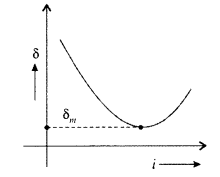
Answer:
- The device identified is a ‘PRISM’.
- For ray diagram and derivation :
(a) The figure shows the passage of light through a triangular prism ABC. The angles of incidence and refraction at the first face AB are i and rv while the angle of incidence (from glass to air) at the second face AC is r
2
and the angle of refraction or emergence e. The angle between the emergent ray RS and the direction of the incident ray PQ is called the angle of deviation δ.

In the quadrilateral AQNR, two of the angles (at the vertices Q and R) are right angles. Therefore, the sum of the other angles of the quadrilateral is 180°.
![]()
From the triangle
![]()
Comparing these two equations, we get
r
1
+ r
2
= A
The total deviation 8 is the sum of deviations at the two faces,

A plot between the angle of deviation and angle of incidence is shown in the figure. In general, any given value of δ, except for i = e, corresponds to two values i and hence of e. This, in fact, is expected from the symmetry of i and e in equation (i) above, i.e., δ remains the same if i and e are. interchanged. Physically, this is related to the fact that the path of ray in the diagram above can be traced back, resulting in the same angle of deviation. At the minimum deviation dm, the refracted ray inside the prism becomes parallel to its base. We have,
![]()
When angle of incidence (i) and angle of emergence (e) are equal, ie,

Question 154.
(a) Draw a ray diagram to show the image formation by a combination of two thin convex lenses in contact. Obtain the expression for the power of this combination in terms of focal lengths of the lenses.
(b) A ray of light passing from air through an equilateral glass prism undergoes minimum deviation when the angle of incidence is \(\frac{3}{4}\)th of the angle prism. Calculate the speed of light in the prism. (All India 2017)
Answer:
(a) Two thin lenses in contact: Two thin lenses, of focal length f
1
and f
2
are kept in contact. Let O be the position of object and let u be the object distance. The distance of the image (which is at I
1
), for the first lens is v
1
.
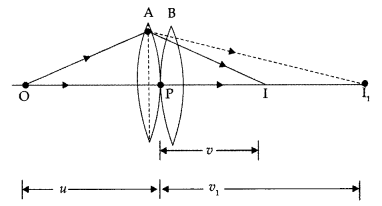
This image serves as object for the second lens.
Let the final image be at I, We then have
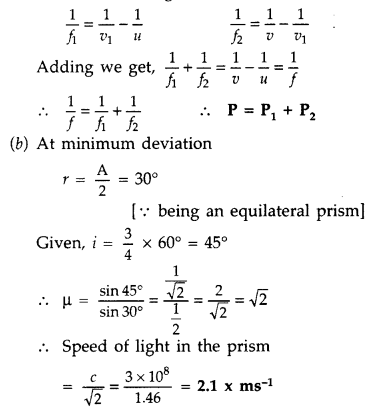
Question 155.
(a) Explain with reason, how the power of a diverging lens changes when
(i) it is kept in a medium of refractive index greater than that of the lens,
(ii) incident red light is replaced by violet light.
(b) Three lenses L
1
L
2
, L
3
each of focal length 30 cm are placed co-axially as shown in the figure. An object is held at 60 cm from the optic centre of Lens L
1
. The final real image is formed at the focus of L
3
. Calculate the separation between
(i) (L
3
and L
2
) and
(ii) (L
2
and L
3
). (Comptt. All India 2017)

Answer:
(a) The power of a lens is the reciprocal of its focal length.
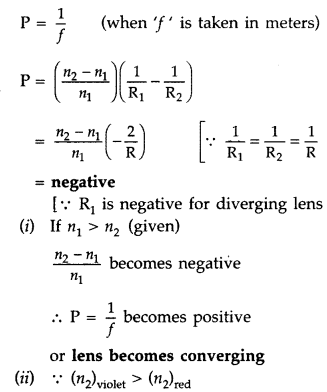
which means that the power of lens increases on changing to violet light from red light.

Since final image (I
3
) is formed at the focus of L
3
, the rays emerging from L
2
and incident on L
3
have to be parallel to principal axis.
Since the object is placed at a distance of 60 cm from L
1
i.e., at 2F; the image will be formed at 2F on the other side of L
1
(60 cm).
This image I
1
will be at the focus of L
2
, because rays emerging out from L
2
are parallel to principal axis.

(ii) L
2
L
3
can be any distance.
Question 156.
(a) Deduce the expression, by drawing a suitable ray diagram, for the refractive index of triangular glass prism in terms of the angle of minimum deviation (D) and the angle of prism (A).
Draw a plot showing the variation of the angle of deviation with the angle of incidence.
(b) Calculate the value of the angle of incidence when a ray of light incident on one face of an equilateral glass prism produces the emergent ray, which just grazes along the adjacent face. Refractive index of the prism is \(\sqrt{2}\). (Comptt. All India 2017)
Answer:
(a) The figure shows the passage of light through a triangular prism ABC. The angles of incidence and refraction at the first face AB are i and rv while the angle of incidence (from glass to air) at the second face AC is r2 and the angle of refraction or emergence e. The angle between the emergent ray RS and the direction of the incident ray PQ is called the angle of deviation δ.

In the quadrilateral AQNR, two of the angles (at the vertices Q and R) are right angles. Therefore, the sum of the other angles of the quadrilateral is 180°.
![]()
From the triangle
![]()
Comparing these two equations, we get
r
1
+ r
2
= A
The total deviation 8 is the sum of deviations at the two faces,

A plot between the angle of deviation and angle of incidence is shown in the figure. In general, any given value of δ, except for i = e, corresponds to two values i and hence of e. This, in fact, is expected from the symmetry of i and e in equation (i) above, i.e., δ remains the same if i and e are. interchanged. Physically, this is related to the fact that the path of ray in the diagram above can be traced back, resulting in the same angle of deviation. At the minimum deviation dm, the refracted ray inside the prism becomes parallel to its base. We have,
![]()
When angle of incidence (i) and angle of emergence (e) are equal, ie,

(b) Given µ = \(\sqrt{2}\), ∠i = ?
Since the emergent ray just grazes along the adjacent face of an equilateral glass prism,
